Caring for a patient with dementia and arthritis who is at risk of injury
VerifiedAdded on 2023/06/12
|21
|5580
|182
AI Summary
This case study is about Ethel Simpson, a 64-year-old patient with dementia and arthritis who is at risk of injury. The article discusses the epidemiology and pathophysiology of musculoskeletal conditions, dementia, and injury prevention and control. The Clinical Reasoning Cycle is used to review nursing priorities for her care.
Contribute Materials
Your contribution can guide someone’s learning journey. Share your
documents today.
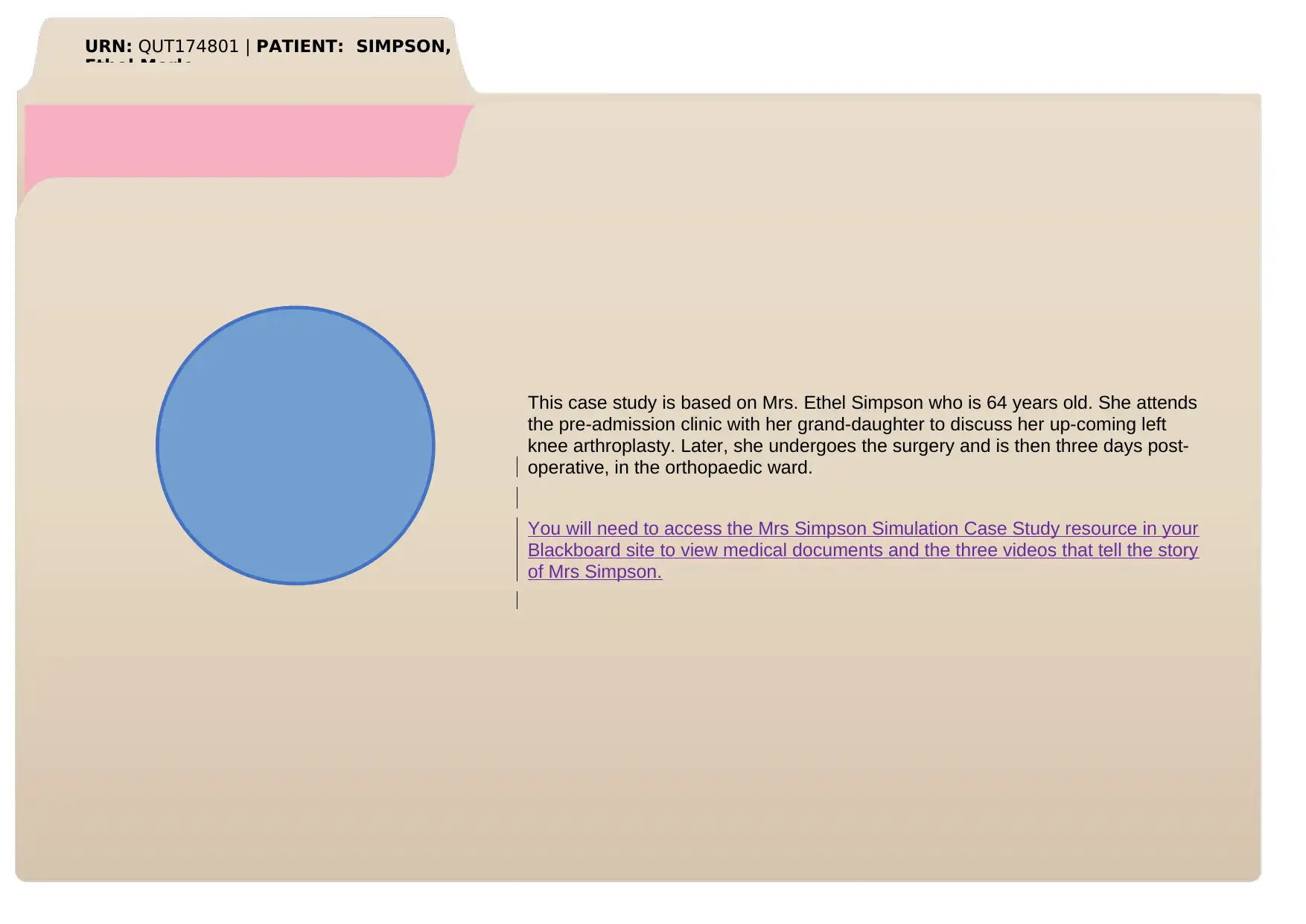
URN: QUT174801 | PATIENT: SIMPSON,
Ethel Merle
This case study is based on Mrs. Ethel Simpson who is 64 years old. She attends
the pre-admission clinic with her grand-daughter to discuss her up-coming left
knee arthroplasty. Later, she undergoes the surgery and is then three days post-
operative, in the orthopaedic ward.
You will need to access the Mrs Simpson Simulation Case Study resource in your
Blackboard site to view medical documents and the three videos that tell the story
of Mrs Simpson.
Ethel Merle
This case study is based on Mrs. Ethel Simpson who is 64 years old. She attends
the pre-admission clinic with her grand-daughter to discuss her up-coming left
knee arthroplasty. Later, she undergoes the surgery and is then three days post-
operative, in the orthopaedic ward.
You will need to access the Mrs Simpson Simulation Case Study resource in your
Blackboard site to view medical documents and the three videos that tell the story
of Mrs Simpson.
Secure Best Marks with AI Grader
Need help grading? Try our AI Grader for instant feedback on your assignments.
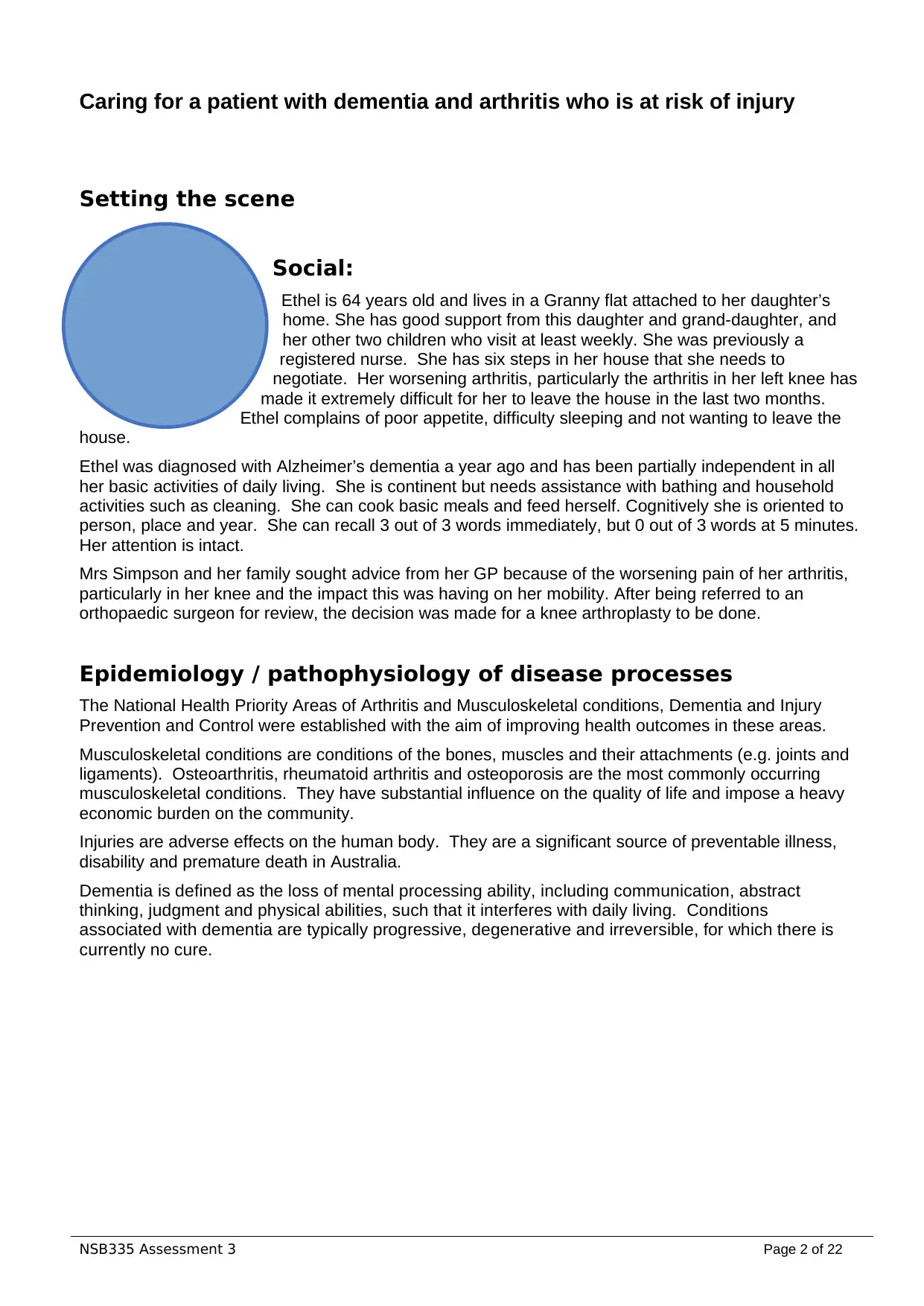
Caring for a patient with dementia and arthritis who is at risk of injury
Setting the scene
Social:
Ethel is 64 years old and lives in a Granny flat attached to her daughter’s
home. She has good support from this daughter and grand-daughter, and
her other two children who visit at least weekly. She was previously a
registered nurse. She has six steps in her house that she needs to
negotiate. Her worsening arthritis, particularly the arthritis in her left knee has
made it extremely difficult for her to leave the house in the last two months.
Ethel complains of poor appetite, difficulty sleeping and not wanting to leave the
house.
Ethel was diagnosed with Alzheimer’s dementia a year ago and has been partially independent in all
her basic activities of daily living. She is continent but needs assistance with bathing and household
activities such as cleaning. She can cook basic meals and feed herself. Cognitively she is oriented to
person, place and year. She can recall 3 out of 3 words immediately, but 0 out of 3 words at 5 minutes.
Her attention is intact.
Mrs Simpson and her family sought advice from her GP because of the worsening pain of her arthritis,
particularly in her knee and the impact this was having on her mobility. After being referred to an
orthopaedic surgeon for review, the decision was made for a knee arthroplasty to be done.
Epidemiology / pathophysiology of disease processes
The National Health Priority Areas of Arthritis and Musculoskeletal conditions, Dementia and Injury
Prevention and Control were established with the aim of improving health outcomes in these areas.
Musculoskeletal conditions are conditions of the bones, muscles and their attachments (e.g. joints and
ligaments). Osteoarthritis, rheumatoid arthritis and osteoporosis are the most commonly occurring
musculoskeletal conditions. They have substantial influence on the quality of life and impose a heavy
economic burden on the community.
Injuries are adverse effects on the human body. They are a significant source of preventable illness,
disability and premature death in Australia.
Dementia is defined as the loss of mental processing ability, including communication, abstract
thinking, judgment and physical abilities, such that it interferes with daily living. Conditions
associated with dementia are typically progressive, degenerative and irreversible, for which there is
currently no cure.
NSB335 Assessment 3 Page 2 of 22
Setting the scene
Social:
Ethel is 64 years old and lives in a Granny flat attached to her daughter’s
home. She has good support from this daughter and grand-daughter, and
her other two children who visit at least weekly. She was previously a
registered nurse. She has six steps in her house that she needs to
negotiate. Her worsening arthritis, particularly the arthritis in her left knee has
made it extremely difficult for her to leave the house in the last two months.
Ethel complains of poor appetite, difficulty sleeping and not wanting to leave the
house.
Ethel was diagnosed with Alzheimer’s dementia a year ago and has been partially independent in all
her basic activities of daily living. She is continent but needs assistance with bathing and household
activities such as cleaning. She can cook basic meals and feed herself. Cognitively she is oriented to
person, place and year. She can recall 3 out of 3 words immediately, but 0 out of 3 words at 5 minutes.
Her attention is intact.
Mrs Simpson and her family sought advice from her GP because of the worsening pain of her arthritis,
particularly in her knee and the impact this was having on her mobility. After being referred to an
orthopaedic surgeon for review, the decision was made for a knee arthroplasty to be done.
Epidemiology / pathophysiology of disease processes
The National Health Priority Areas of Arthritis and Musculoskeletal conditions, Dementia and Injury
Prevention and Control were established with the aim of improving health outcomes in these areas.
Musculoskeletal conditions are conditions of the bones, muscles and their attachments (e.g. joints and
ligaments). Osteoarthritis, rheumatoid arthritis and osteoporosis are the most commonly occurring
musculoskeletal conditions. They have substantial influence on the quality of life and impose a heavy
economic burden on the community.
Injuries are adverse effects on the human body. They are a significant source of preventable illness,
disability and premature death in Australia.
Dementia is defined as the loss of mental processing ability, including communication, abstract
thinking, judgment and physical abilities, such that it interferes with daily living. Conditions
associated with dementia are typically progressive, degenerative and irreversible, for which there is
currently no cure.
NSB335 Assessment 3 Page 2 of 22
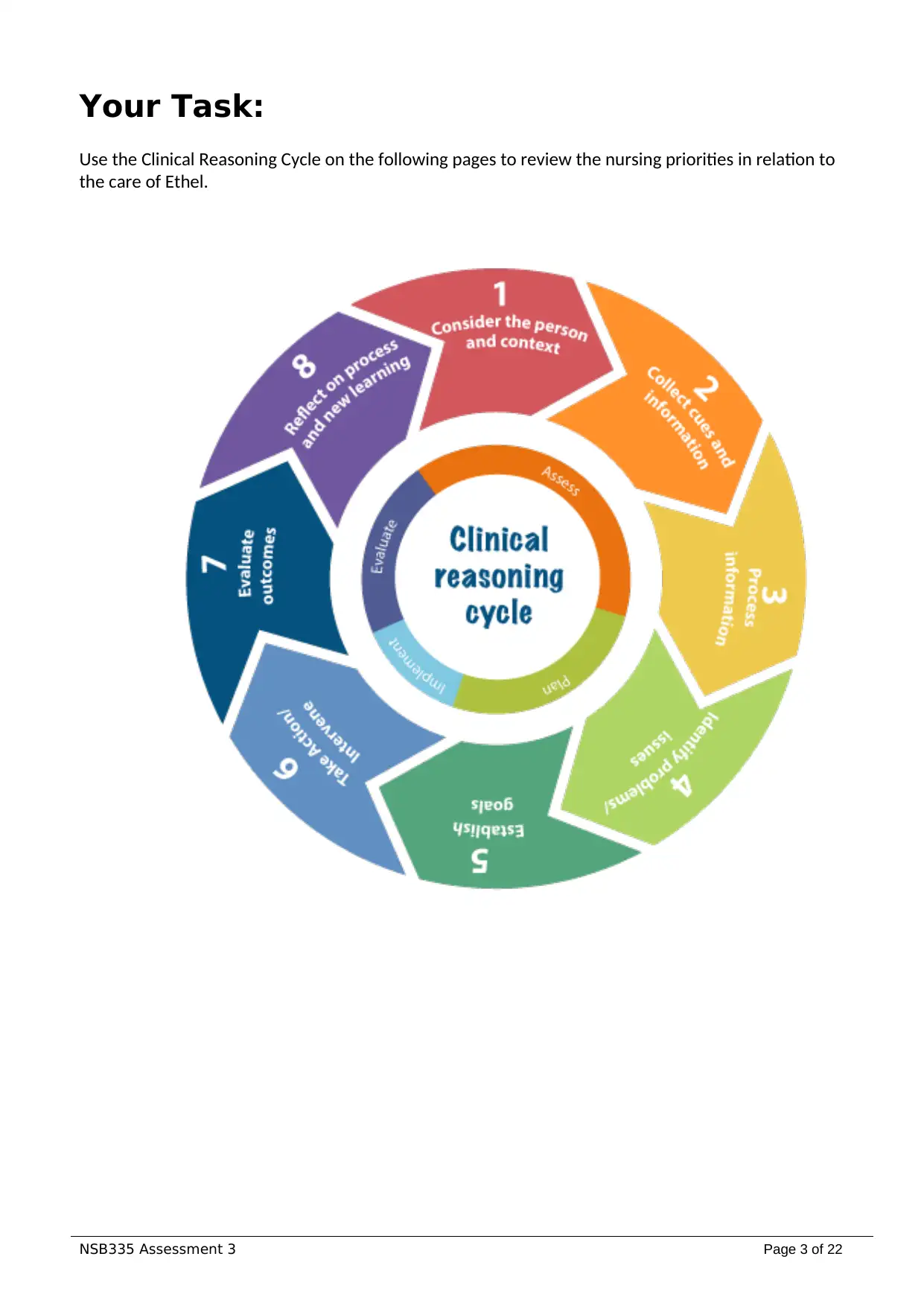
Your Task:
Use the Clinical Reasoning Cycle on the following pages to review the nursing priorities in relation to
the care of Ethel.
NSB335 Assessment 3 Page 3 of 22
Use the Clinical Reasoning Cycle on the following pages to review the nursing priorities in relation to
the care of Ethel.
NSB335 Assessment 3 Page 3 of 22
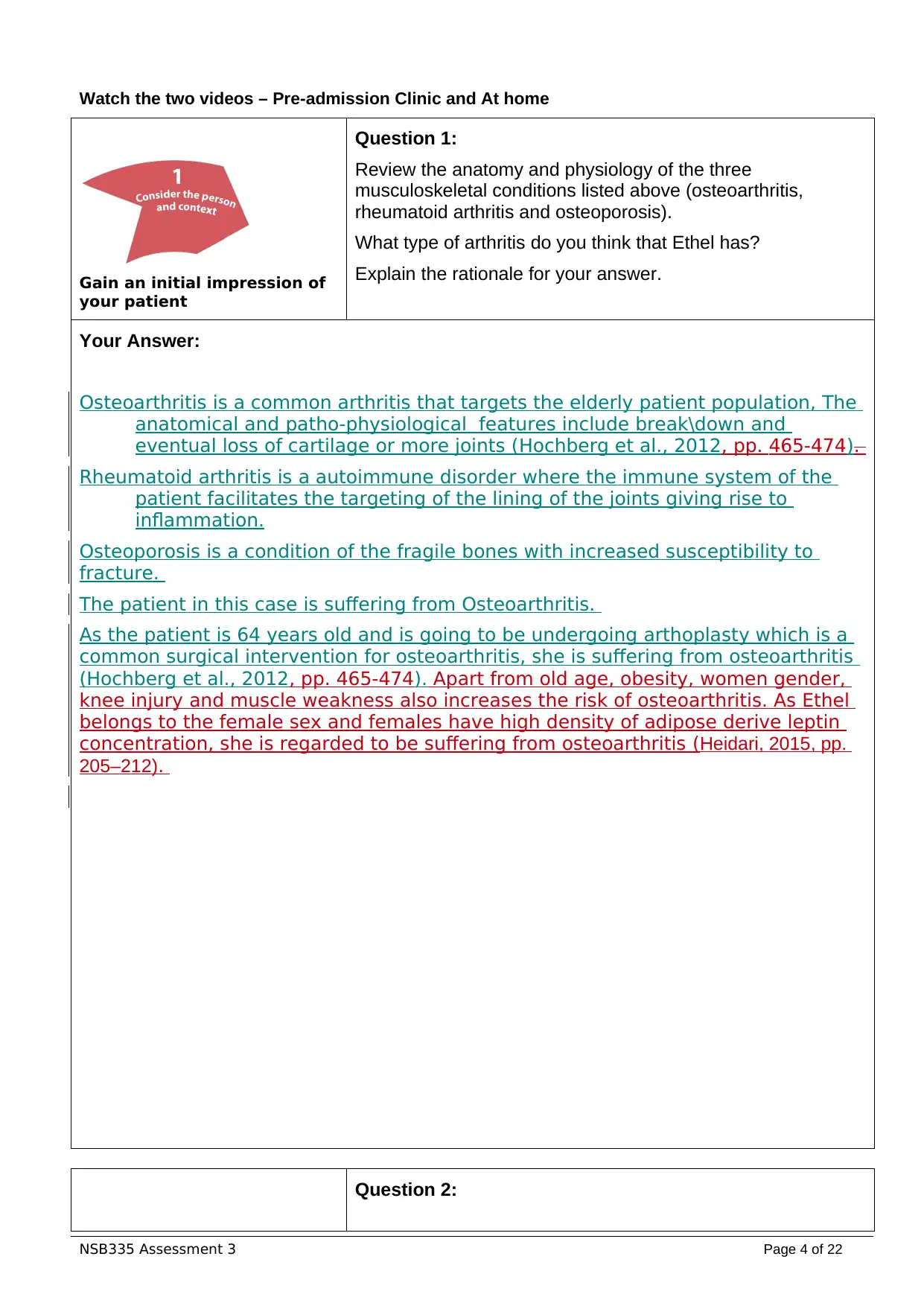
Watch the two videos – Pre-admission Clinic and At home
Gain an initial impression of
your patient
Question 1:
Review the anatomy and physiology of the three
musculoskeletal conditions listed above (osteoarthritis,
rheumatoid arthritis and osteoporosis).
What type of arthritis do you think that Ethel has?
Explain the rationale for your answer.
Your Answer:
Osteoarthritis is a common arthritis that targets the elderly patient population, The
anatomical and patho-physiological features include break\down and
eventual loss of cartilage or more joints (Hochberg et al., 2012, pp. 465-474).
Rheumatoid arthritis is a autoimmune disorder where the immune system of the
patient facilitates the targeting of the lining of the joints giving rise to
inflammation.
Osteoporosis is a condition of the fragile bones with increased susceptibility to
fracture.
The patient in this case is suffering from Osteoarthritis.
As the patient is 64 years old and is going to be undergoing arthoplasty which is a
common surgical intervention for osteoarthritis, she is suffering from osteoarthritis
(Hochberg et al., 2012, pp. 465-474). Apart from old age, obesity, women gender,
knee injury and muscle weakness also increases the risk of osteoarthritis. As Ethel
belongs to the female sex and females have high density of adipose derive leptin
concentration, she is regarded to be suffering from osteoarthritis (Heidari, 2015, pp.
205–212).
Question 2:
NSB335 Assessment 3 Page 4 of 22
Gain an initial impression of
your patient
Question 1:
Review the anatomy and physiology of the three
musculoskeletal conditions listed above (osteoarthritis,
rheumatoid arthritis and osteoporosis).
What type of arthritis do you think that Ethel has?
Explain the rationale for your answer.
Your Answer:
Osteoarthritis is a common arthritis that targets the elderly patient population, The
anatomical and patho-physiological features include break\down and
eventual loss of cartilage or more joints (Hochberg et al., 2012, pp. 465-474).
Rheumatoid arthritis is a autoimmune disorder where the immune system of the
patient facilitates the targeting of the lining of the joints giving rise to
inflammation.
Osteoporosis is a condition of the fragile bones with increased susceptibility to
fracture.
The patient in this case is suffering from Osteoarthritis.
As the patient is 64 years old and is going to be undergoing arthoplasty which is a
common surgical intervention for osteoarthritis, she is suffering from osteoarthritis
(Hochberg et al., 2012, pp. 465-474). Apart from old age, obesity, women gender,
knee injury and muscle weakness also increases the risk of osteoarthritis. As Ethel
belongs to the female sex and females have high density of adipose derive leptin
concentration, she is regarded to be suffering from osteoarthritis (Heidari, 2015, pp.
205–212).
Question 2:
NSB335 Assessment 3 Page 4 of 22
Secure Best Marks with AI Grader
Need help grading? Try our AI Grader for instant feedback on your assignments.
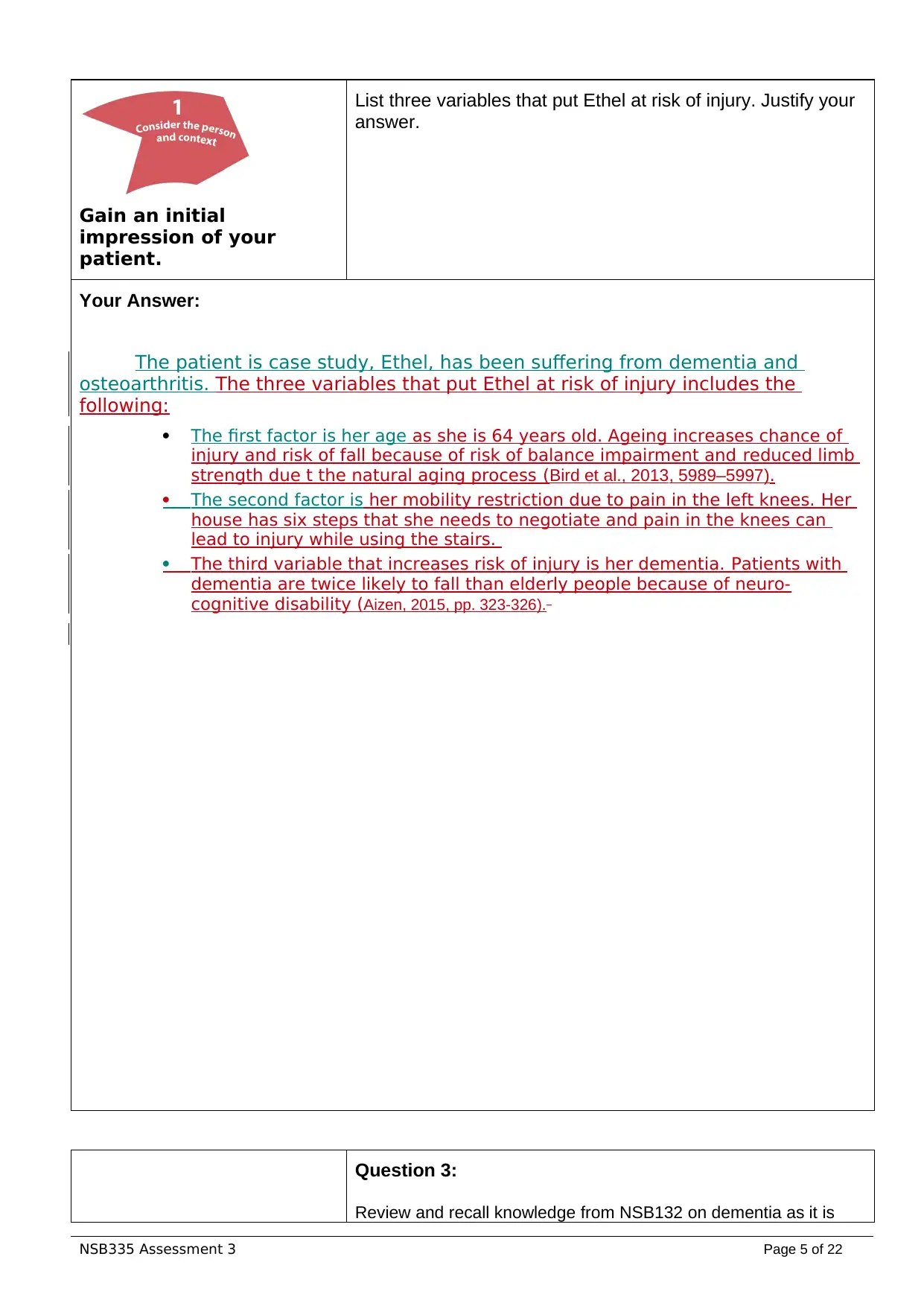
Gain an initial
impression of your
patient.
List three variables that put Ethel at risk of injury. Justify your
answer.
Your Answer:
The patient is case study, Ethel, has been suffering from dementia and
osteoarthritis. The three variables that put Ethel at risk of injury includes the
following:
The first factor is her age as she is 64 years old. Ageing increases chance of
injury and risk of fall because of risk of balance impairment and reduced limb
strength due t the natural aging process (Bird et al., 2013, 5989–5997).
The second factor is her mobility restriction due to pain in the left knees. Her
house has six steps that she needs to negotiate and pain in the knees can
lead to injury while using the stairs.
The third variable that increases risk of injury is her dementia. Patients with
dementia are twice likely to fall than elderly people because of neuro-
cognitive disability (Aizen, 2015, pp. 323-326).
Question 3:
Review and recall knowledge from NSB132 on dementia as it is
NSB335 Assessment 3 Page 5 of 22
impression of your
patient.
List three variables that put Ethel at risk of injury. Justify your
answer.
Your Answer:
The patient is case study, Ethel, has been suffering from dementia and
osteoarthritis. The three variables that put Ethel at risk of injury includes the
following:
The first factor is her age as she is 64 years old. Ageing increases chance of
injury and risk of fall because of risk of balance impairment and reduced limb
strength due t the natural aging process (Bird et al., 2013, 5989–5997).
The second factor is her mobility restriction due to pain in the left knees. Her
house has six steps that she needs to negotiate and pain in the knees can
lead to injury while using the stairs.
The third variable that increases risk of injury is her dementia. Patients with
dementia are twice likely to fall than elderly people because of neuro-
cognitive disability (Aizen, 2015, pp. 323-326).
Question 3:
Review and recall knowledge from NSB132 on dementia as it is
NSB335 Assessment 3 Page 5 of 22
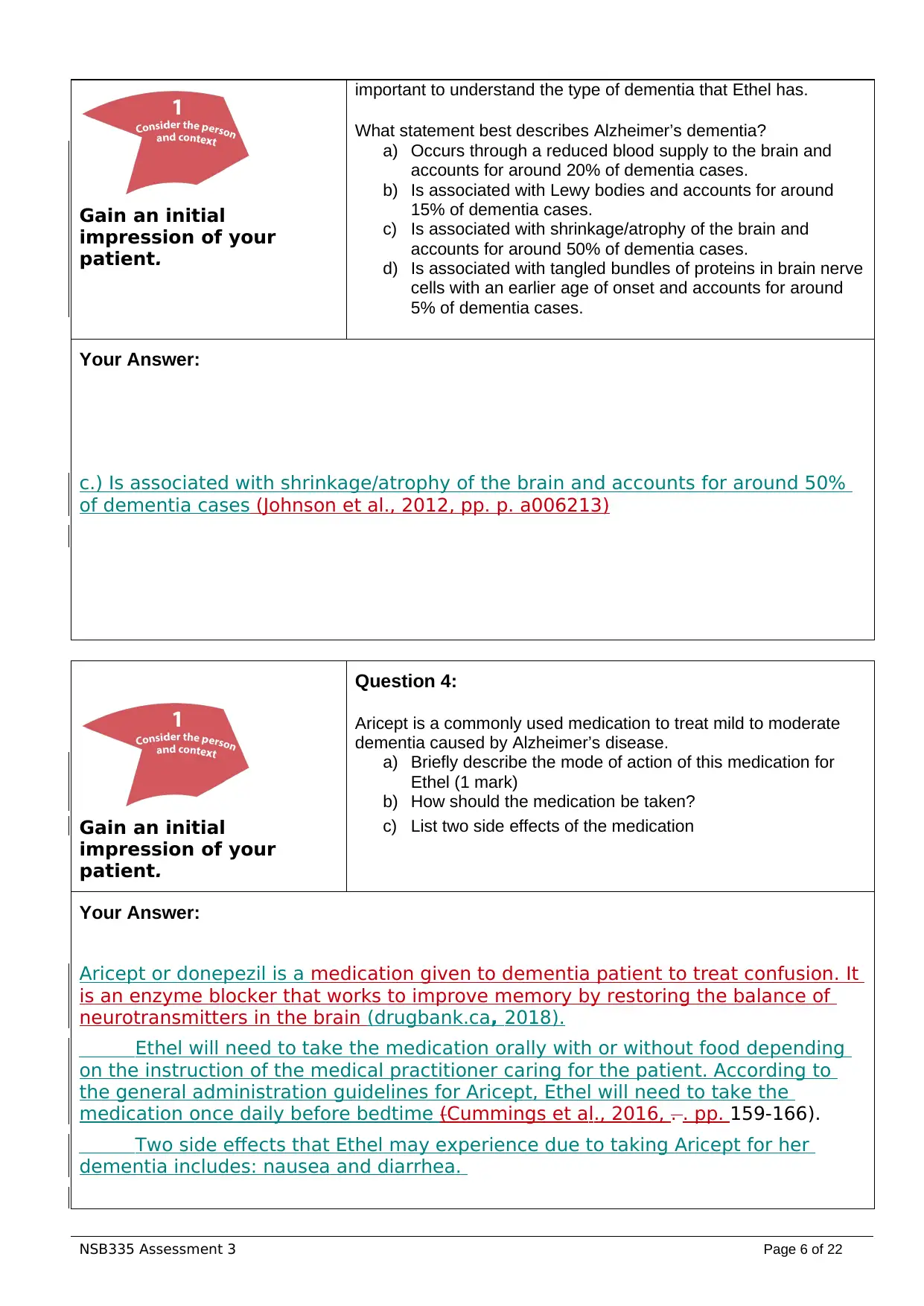
Gain an initial
impression of your
patient.
important to understand the type of dementia that Ethel has.
What statement best describes Alzheimer’s dementia?
a) Occurs through a reduced blood supply to the brain and
accounts for around 20% of dementia cases.
b) Is associated with Lewy bodies and accounts for around
15% of dementia cases.
c) Is associated with shrinkage/atrophy of the brain and
accounts for around 50% of dementia cases.
d) Is associated with tangled bundles of proteins in brain nerve
cells with an earlier age of onset and accounts for around
5% of dementia cases.
Your Answer:
c.) Is associated with shrinkage/atrophy of the brain and accounts for around 50%
of dementia cases (Johnson et al., 2012, pp. p. a006213)
Gain an initial
impression of your
patient.
Question 4:
Aricept is a commonly used medication to treat mild to moderate
dementia caused by Alzheimer’s disease.
a) Briefly describe the mode of action of this medication for
Ethel (1 mark)
b) How should the medication be taken?
c) List two side effects of the medication
Your Answer:
Aricept or donepezil is a medication given to dementia patient to treat confusion. It
is an enzyme blocker that works to improve memory by restoring the balance of
neurotransmitters in the brain (drugbank.ca, 2018).
Ethel will need to take the medication orally with or without food depending
on the instruction of the medical practitioner caring for the patient. According to
the general administration guidelines for Aricept, Ethel will need to take the
medication once daily before bedtime (Cummings et al., 2016, . . pp. 159-166).
Two side effects that Ethel may experience due to taking Aricept for her
dementia includes: nausea and diarrhea.
NSB335 Assessment 3 Page 6 of 22
impression of your
patient.
important to understand the type of dementia that Ethel has.
What statement best describes Alzheimer’s dementia?
a) Occurs through a reduced blood supply to the brain and
accounts for around 20% of dementia cases.
b) Is associated with Lewy bodies and accounts for around
15% of dementia cases.
c) Is associated with shrinkage/atrophy of the brain and
accounts for around 50% of dementia cases.
d) Is associated with tangled bundles of proteins in brain nerve
cells with an earlier age of onset and accounts for around
5% of dementia cases.
Your Answer:
c.) Is associated with shrinkage/atrophy of the brain and accounts for around 50%
of dementia cases (Johnson et al., 2012, pp. p. a006213)
Gain an initial
impression of your
patient.
Question 4:
Aricept is a commonly used medication to treat mild to moderate
dementia caused by Alzheimer’s disease.
a) Briefly describe the mode of action of this medication for
Ethel (1 mark)
b) How should the medication be taken?
c) List two side effects of the medication
Your Answer:
Aricept or donepezil is a medication given to dementia patient to treat confusion. It
is an enzyme blocker that works to improve memory by restoring the balance of
neurotransmitters in the brain (drugbank.ca, 2018).
Ethel will need to take the medication orally with or without food depending
on the instruction of the medical practitioner caring for the patient. According to
the general administration guidelines for Aricept, Ethel will need to take the
medication once daily before bedtime (Cummings et al., 2016, . . pp. 159-166).
Two side effects that Ethel may experience due to taking Aricept for her
dementia includes: nausea and diarrhea.
NSB335 Assessment 3 Page 6 of 22
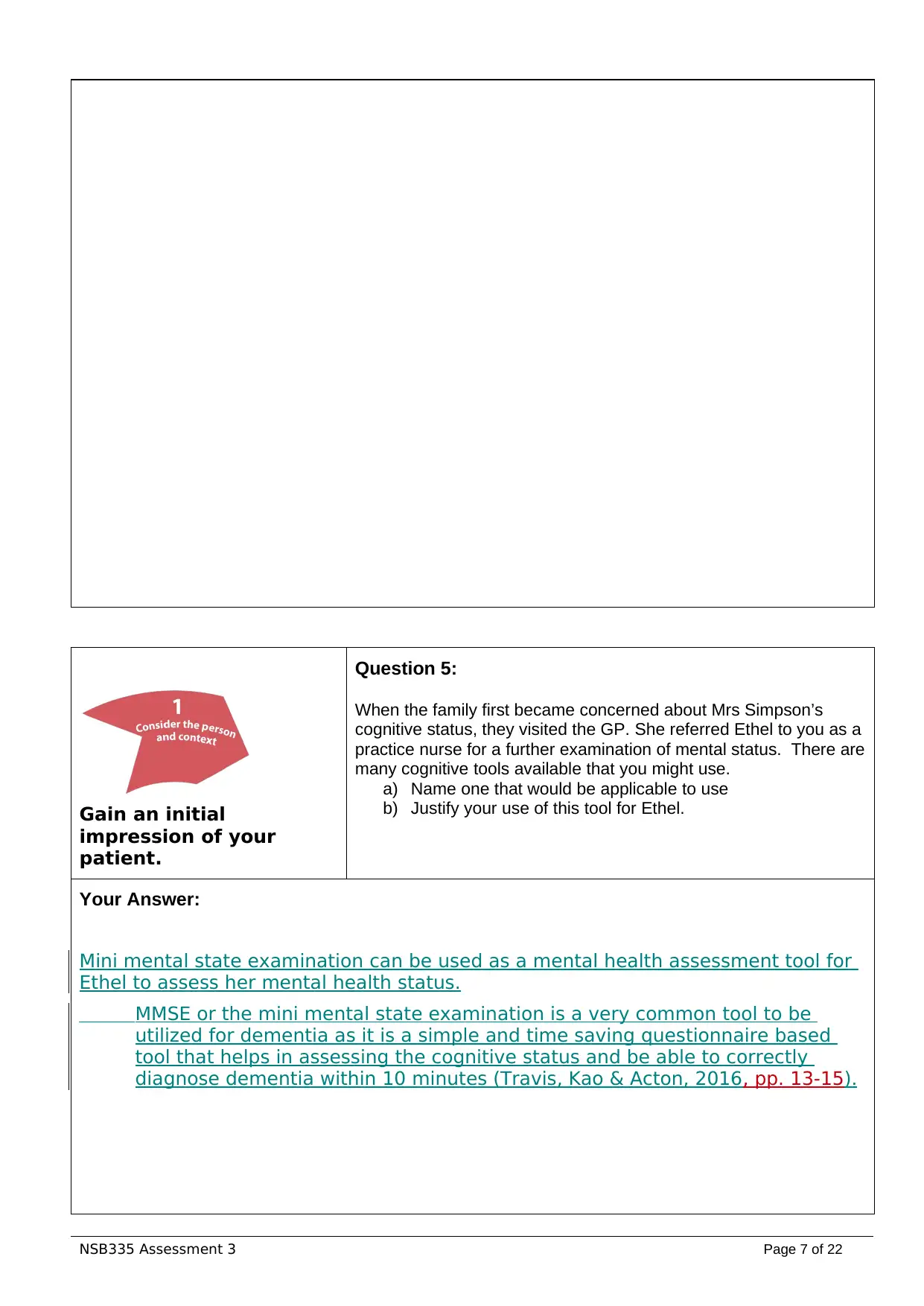
Gain an initial
impression of your
patient.
Question 5:
When the family first became concerned about Mrs Simpson’s
cognitive status, they visited the GP. She referred Ethel to you as a
practice nurse for a further examination of mental status. There are
many cognitive tools available that you might use.
a) Name one that would be applicable to use
b) Justify your use of this tool for Ethel.
Your Answer:
Mini mental state examination can be used as a mental health assessment tool for
Ethel to assess her mental health status.
MMSE or the mini mental state examination is a very common tool to be
utilized for dementia as it is a simple and time saving questionnaire based
tool that helps in assessing the cognitive status and be able to correctly
diagnose dementia within 10 minutes (Travis, Kao & Acton, 2016, pp. 13-15).
NSB335 Assessment 3 Page 7 of 22
impression of your
patient.
Question 5:
When the family first became concerned about Mrs Simpson’s
cognitive status, they visited the GP. She referred Ethel to you as a
practice nurse for a further examination of mental status. There are
many cognitive tools available that you might use.
a) Name one that would be applicable to use
b) Justify your use of this tool for Ethel.
Your Answer:
Mini mental state examination can be used as a mental health assessment tool for
Ethel to assess her mental health status.
MMSE or the mini mental state examination is a very common tool to be
utilized for dementia as it is a simple and time saving questionnaire based
tool that helps in assessing the cognitive status and be able to correctly
diagnose dementia within 10 minutes (Travis, Kao & Acton, 2016, pp. 13-15).
NSB335 Assessment 3 Page 7 of 22
Paraphrase This Document
Need a fresh take? Get an instant paraphrase of this document with our AI Paraphraser
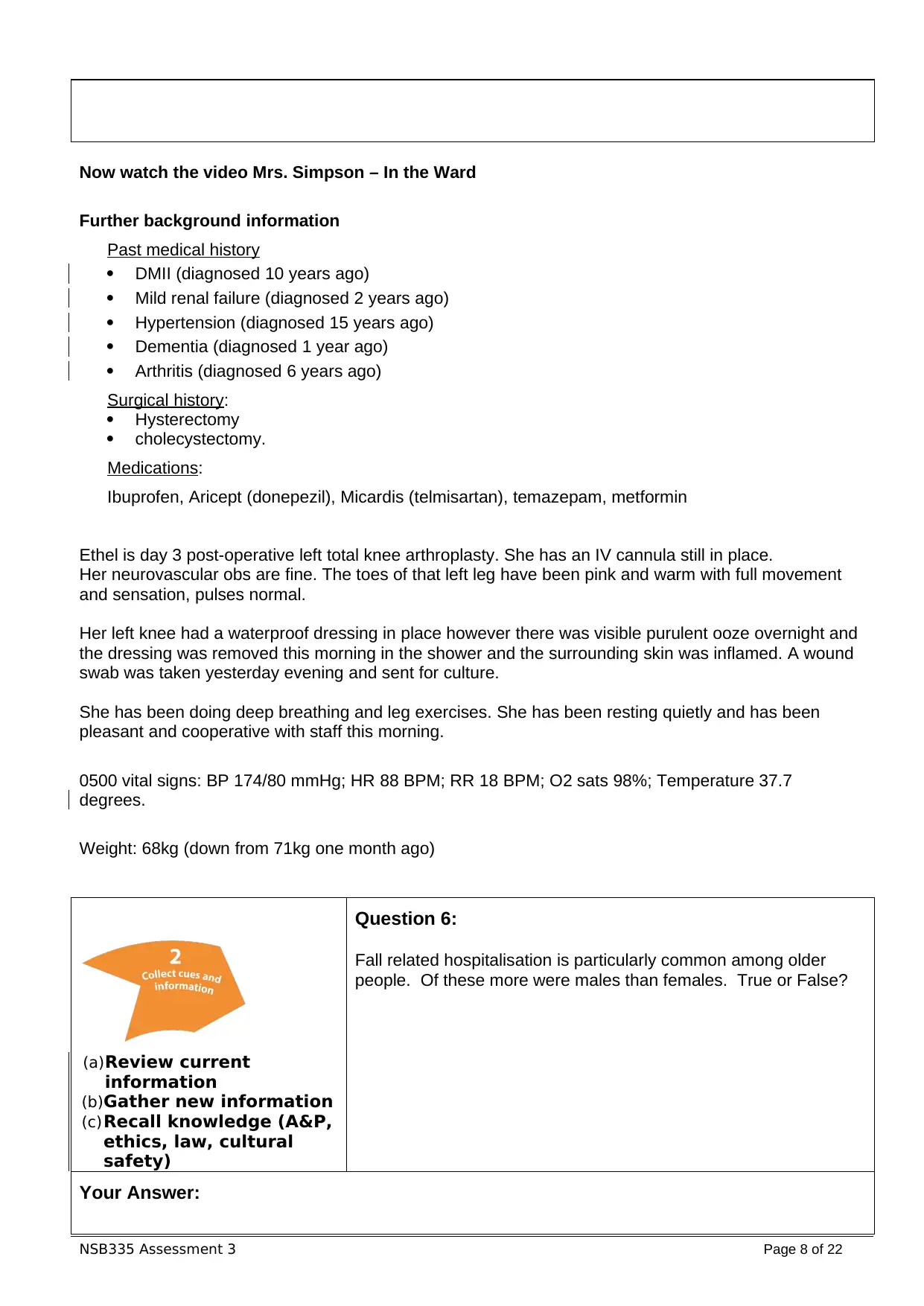
Now watch the video Mrs. Simpson – In the Ward
Further background information
Past medical history
DMII (diagnosed 10 years ago)
Mild renal failure (diagnosed 2 years ago)
Hypertension (diagnosed 15 years ago)
Dementia (diagnosed 1 year ago)
Arthritis (diagnosed 6 years ago)
Surgical history:
Hysterectomy
cholecystectomy.
Medications:
Ibuprofen, Aricept (donepezil), Micardis (telmisartan), temazepam, metformin
Ethel is day 3 post-operative left total knee arthroplasty. She has an IV cannula still in place.
Her neurovascular obs are fine. The toes of that left leg have been pink and warm with full movement
and sensation, pulses normal.
Her left knee had a waterproof dressing in place however there was visible purulent ooze overnight and
the dressing was removed this morning in the shower and the surrounding skin was inflamed. A wound
swab was taken yesterday evening and sent for culture.
She has been doing deep breathing and leg exercises. She has been resting quietly and has been
pleasant and cooperative with staff this morning.
0500 vital signs: BP 174/80 mmHg; HR 88 BPM; RR 18 BPM; O2 sats 98%; Temperature 37.7
degrees.
Weight: 68kg (down from 71kg one month ago)
(a)Review current
information
(b)Gather new information
(c)Recall knowledge (A&P,
ethics, law, cultural
safety)
Question 6:
Fall related hospitalisation is particularly common among older
people. Of these more were males than females. True or False?
Your Answer:
NSB335 Assessment 3 Page 8 of 22
Further background information
Past medical history
DMII (diagnosed 10 years ago)
Mild renal failure (diagnosed 2 years ago)
Hypertension (diagnosed 15 years ago)
Dementia (diagnosed 1 year ago)
Arthritis (diagnosed 6 years ago)
Surgical history:
Hysterectomy
cholecystectomy.
Medications:
Ibuprofen, Aricept (donepezil), Micardis (telmisartan), temazepam, metformin
Ethel is day 3 post-operative left total knee arthroplasty. She has an IV cannula still in place.
Her neurovascular obs are fine. The toes of that left leg have been pink and warm with full movement
and sensation, pulses normal.
Her left knee had a waterproof dressing in place however there was visible purulent ooze overnight and
the dressing was removed this morning in the shower and the surrounding skin was inflamed. A wound
swab was taken yesterday evening and sent for culture.
She has been doing deep breathing and leg exercises. She has been resting quietly and has been
pleasant and cooperative with staff this morning.
0500 vital signs: BP 174/80 mmHg; HR 88 BPM; RR 18 BPM; O2 sats 98%; Temperature 37.7
degrees.
Weight: 68kg (down from 71kg one month ago)
(a)Review current
information
(b)Gather new information
(c)Recall knowledge (A&P,
ethics, law, cultural
safety)
Question 6:
Fall related hospitalisation is particularly common among older
people. Of these more were males than females. True or False?
Your Answer:
NSB335 Assessment 3 Page 8 of 22
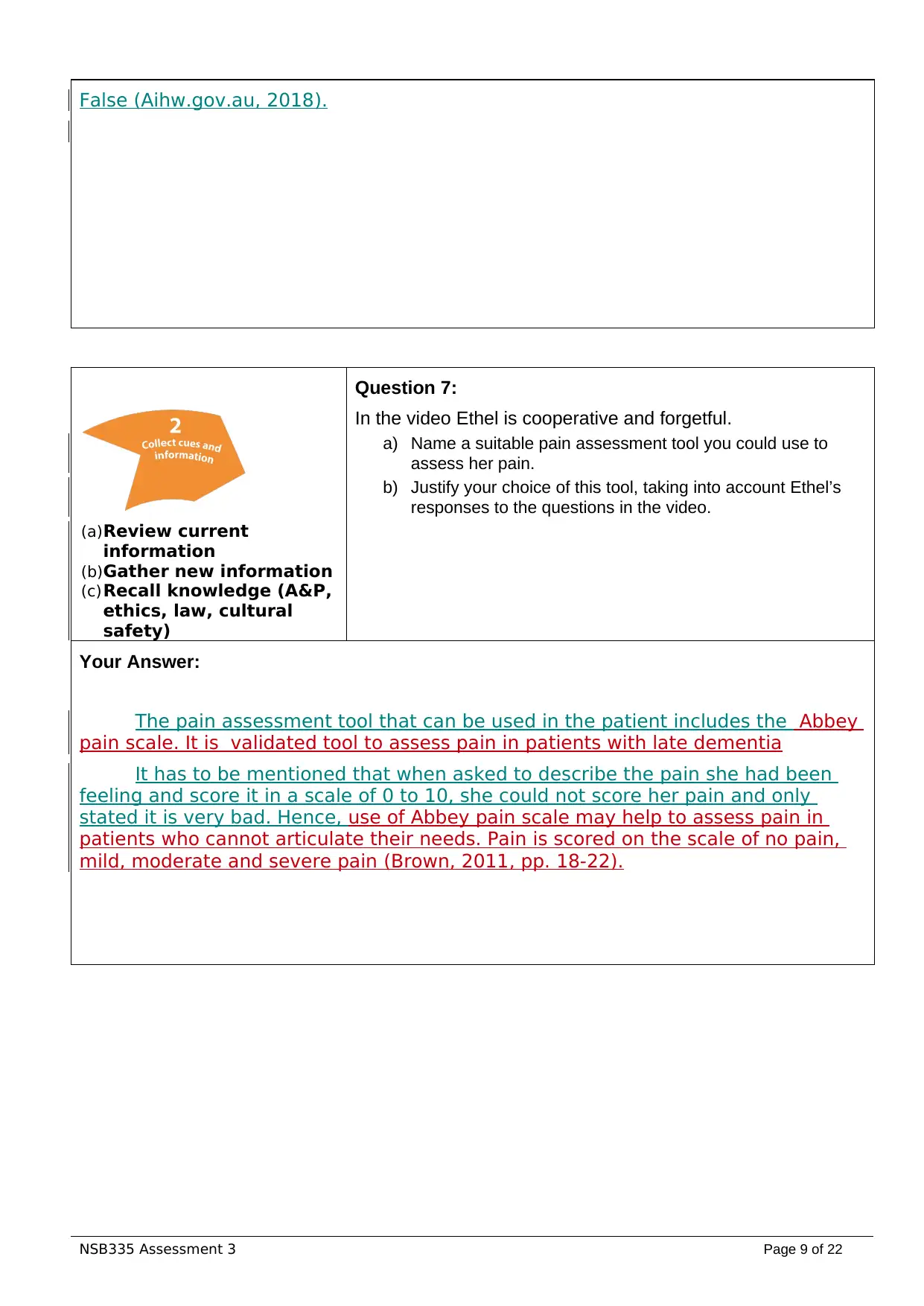
False (Aihw.gov.au, 2018).
(a)Review current
information
(b)Gather new information
(c)Recall knowledge (A&P,
ethics, law, cultural
safety)
Question 7:
In the video Ethel is cooperative and forgetful.
a) Name a suitable pain assessment tool you could use to
assess her pain.
b) Justify your choice of this tool, taking into account Ethel’s
responses to the questions in the video.
Your Answer:
The pain assessment tool that can be used in the patient includes the Abbey
pain scale. It is validated tool to assess pain in patients with late dementia
It has to be mentioned that when asked to describe the pain she had been
feeling and score it in a scale of 0 to 10, she could not score her pain and only
stated it is very bad. Hence, use of Abbey pain scale may help to assess pain in
patients who cannot articulate their needs. Pain is scored on the scale of no pain,
mild, moderate and severe pain (Brown, 2011, pp. 18-22).
NSB335 Assessment 3 Page 9 of 22
(a)Review current
information
(b)Gather new information
(c)Recall knowledge (A&P,
ethics, law, cultural
safety)
Question 7:
In the video Ethel is cooperative and forgetful.
a) Name a suitable pain assessment tool you could use to
assess her pain.
b) Justify your choice of this tool, taking into account Ethel’s
responses to the questions in the video.
Your Answer:
The pain assessment tool that can be used in the patient includes the Abbey
pain scale. It is validated tool to assess pain in patients with late dementia
It has to be mentioned that when asked to describe the pain she had been
feeling and score it in a scale of 0 to 10, she could not score her pain and only
stated it is very bad. Hence, use of Abbey pain scale may help to assess pain in
patients who cannot articulate their needs. Pain is scored on the scale of no pain,
mild, moderate and severe pain (Brown, 2011, pp. 18-22).
NSB335 Assessment 3 Page 9 of 22
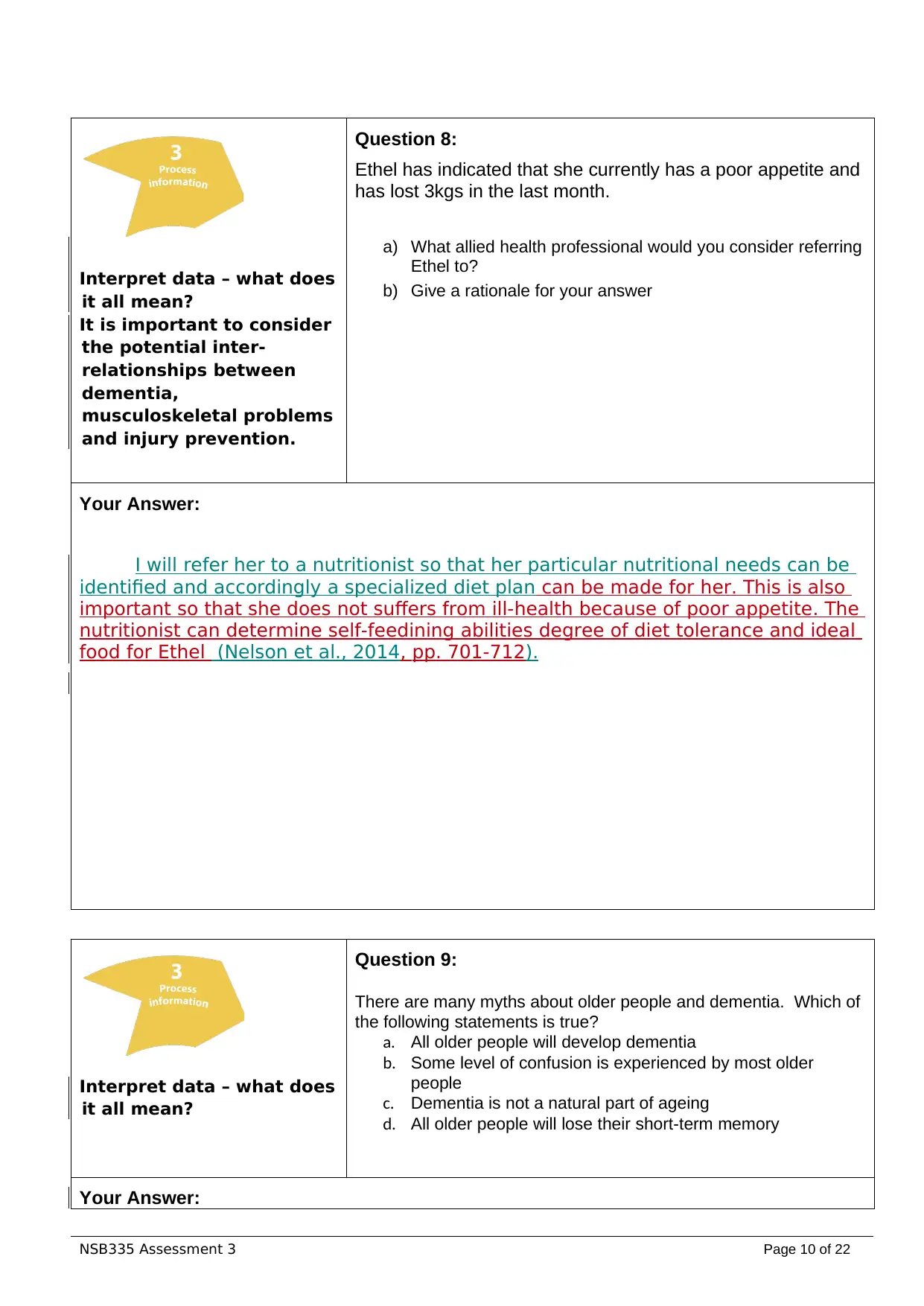
Interpret data – what does
it all mean?
It is important to consider
the potential inter-
relationships between
dementia,
musculoskeletal problems
and injury prevention.
Question 8:
Ethel has indicated that she currently has a poor appetite and
has lost 3kgs in the last month.
a) What allied health professional would you consider referring
Ethel to?
b) Give a rationale for your answer
Your Answer:
I will refer her to a nutritionist so that her particular nutritional needs can be
identified and accordingly a specialized diet plan can be made for her. This is also
important so that she does not suffers from ill-health because of poor appetite. The
nutritionist can determine self-feedining abilities degree of diet tolerance and ideal
food for Ethel (Nelson et al., 2014, pp. 701-712).
Interpret data – what does
it all mean?
Question 9:
There are many myths about older people and dementia. Which of
the following statements is true?
a. All older people will develop dementia
b. Some level of confusion is experienced by most older
people
c. Dementia is not a natural part of ageing
d. All older people will lose their short-term memory
Your Answer:
NSB335 Assessment 3 Page 10 of 22
it all mean?
It is important to consider
the potential inter-
relationships between
dementia,
musculoskeletal problems
and injury prevention.
Question 8:
Ethel has indicated that she currently has a poor appetite and
has lost 3kgs in the last month.
a) What allied health professional would you consider referring
Ethel to?
b) Give a rationale for your answer
Your Answer:
I will refer her to a nutritionist so that her particular nutritional needs can be
identified and accordingly a specialized diet plan can be made for her. This is also
important so that she does not suffers from ill-health because of poor appetite. The
nutritionist can determine self-feedining abilities degree of diet tolerance and ideal
food for Ethel (Nelson et al., 2014, pp. 701-712).
Interpret data – what does
it all mean?
Question 9:
There are many myths about older people and dementia. Which of
the following statements is true?
a. All older people will develop dementia
b. Some level of confusion is experienced by most older
people
c. Dementia is not a natural part of ageing
d. All older people will lose their short-term memory
Your Answer:
NSB335 Assessment 3 Page 10 of 22
Secure Best Marks with AI Grader
Need help grading? Try our AI Grader for instant feedback on your assignments.

c.
Old age is associated with a few health restrictions and the reduction in the
cognitive functioning is one of the most abundant changes that are brought
forward due to aging. According to the recent report, the incident rates of 3Ds
(Delirium, Depression and Dementia), is also alarmingly high in the elderly
populations, among which delirium is most common. It has to be mentioned that
with aging, a small percentage of baseline cognitive functioning decreases paving
way for delirium. Hence, small level of confusion is experienced by most of the
older people however the probability of developing delirium or related mental
disorders is dependent on the age, genetic predisposition and severity of the
cognitive impairment (Thomas et al., 2012, 1471-1477).
………………………………………………………………………………………………………………………
…………………………………………
Synthesise all information
that has been collected
and processed.
Question 10:
Select from the list below the three highest priority relevant
nursing diagnoses for Ethel. Justify your answer.
a) Impaired balance
b) Acute confusional state
c) Cognitive impairment
d) Insomnia
e) Pain
f) Signs of infection in left knee
g) Altered nutrition/hydration
h) Antisocial personality disorder
Your Answer:
The first nursing priority nursing diagnosis for Ethel will be the Pain, as the
patient had been suffering from osteoarthritis. In the initial patient assessment
interview, Ethel had stated the fact that Ethel had been suffering from due to which
she had to undergo a knee replacement surgery. In the postoperative period, as
well as soon as her pain relief medication wore off, she began to feel an
excruciating pain, which is very commonly observed in case of knee replacement
surgery. Hence, the pain management is the first nursing priority (Lockwood, Kable,
& Hunter, 2018, pp. e1048-e1060.).
The second nursing diagnosis is the nutritional impairment. In justification, it
NSB335 Assessment 3 Page 11 of 22
Old age is associated with a few health restrictions and the reduction in the
cognitive functioning is one of the most abundant changes that are brought
forward due to aging. According to the recent report, the incident rates of 3Ds
(Delirium, Depression and Dementia), is also alarmingly high in the elderly
populations, among which delirium is most common. It has to be mentioned that
with aging, a small percentage of baseline cognitive functioning decreases paving
way for delirium. Hence, small level of confusion is experienced by most of the
older people however the probability of developing delirium or related mental
disorders is dependent on the age, genetic predisposition and severity of the
cognitive impairment (Thomas et al., 2012, 1471-1477).
………………………………………………………………………………………………………………………
…………………………………………
Synthesise all information
that has been collected
and processed.
Question 10:
Select from the list below the three highest priority relevant
nursing diagnoses for Ethel. Justify your answer.
a) Impaired balance
b) Acute confusional state
c) Cognitive impairment
d) Insomnia
e) Pain
f) Signs of infection in left knee
g) Altered nutrition/hydration
h) Antisocial personality disorder
Your Answer:
The first nursing priority nursing diagnosis for Ethel will be the Pain, as the
patient had been suffering from osteoarthritis. In the initial patient assessment
interview, Ethel had stated the fact that Ethel had been suffering from due to which
she had to undergo a knee replacement surgery. In the postoperative period, as
well as soon as her pain relief medication wore off, she began to feel an
excruciating pain, which is very commonly observed in case of knee replacement
surgery. Hence, the pain management is the first nursing priority (Lockwood, Kable,
& Hunter, 2018, pp. e1048-e1060.).
The second nursing diagnosis is the nutritional impairment. In justification, it
NSB335 Assessment 3 Page 11 of 22

can be mentioned that the patient had been reported to be experiencing loss which
led to her losing 3 kg in the past month. In the post operative state, as she had
high blood sugar as well, the lack of proper nutrition can slow down her recovery
progress and can even cause hyperglycemic attack.
The third nursing priority for the patient will be the risk of falling which can
lead to injuries. Ethel had been suffering from osteoarthritis for which she had to
undergo a knee replacement surgery. Hence, the patient had been extremely
mobility restricted and as there had not been any bed rails in the cabin she was
staying in, the risk of fall was very high (Lockwood, Kable, & Hunter, 2018, pp.
e1048-e1060).
As a nurse, what are your
desired outcomes for
Ethel?
Question 11:
From the list below choose the three most important short-
term goals for Ethel’s management at this time: Justify your
answer.
a) For Ethel’s weight to stabilise
b) For Ethel to sleep for eight hours/night
c) For Ethel’s pain to be managed
d) For Ethel to be more social
e) To ensure the prevention of injury for Ethel
f) For Ethel to be placed in a residential aged care facility
g) For Ethel’s wound infection to be treated.
Your Answer:
The three short term goals for Ethel are:
For Ethel’s pain to be managed: as mentioned above the patient had been in
excruciating pain post her surgery and Ethel had been increasingly getting restless
due to the pain that she had been feeling and hence the first short term goal for her
will be pain management
For Ethel’s wound infection to be treated: in the post operative scenario for Ethel, it
has been discovered that her excruciating pain had been due to the hospital
acquired infection in the surgical wound after her surgery. According to Lockwood,
Kable, and Hunter (2018, e1048-e1060), Hospital acquired infections are the
primary factors contributing to many complications for the patient other than the
pain and can lead to fatal consequences like sepsis if not treated immediately.
To ensure the prevention of injury for Ethel: As she had been an elderly patient with
mobility restrictions due to her arthritis and the surgery, she is at increased risk of
fall injuries. Her confused mental state and restlessness due to the increasing pain
further enhances the risk, hence, prevention of injury is very important for Ethel’s
safety.
NSB335 Assessment 3 Page 12 of 22
led to her losing 3 kg in the past month. In the post operative state, as she had
high blood sugar as well, the lack of proper nutrition can slow down her recovery
progress and can even cause hyperglycemic attack.
The third nursing priority for the patient will be the risk of falling which can
lead to injuries. Ethel had been suffering from osteoarthritis for which she had to
undergo a knee replacement surgery. Hence, the patient had been extremely
mobility restricted and as there had not been any bed rails in the cabin she was
staying in, the risk of fall was very high (Lockwood, Kable, & Hunter, 2018, pp.
e1048-e1060).
As a nurse, what are your
desired outcomes for
Ethel?
Question 11:
From the list below choose the three most important short-
term goals for Ethel’s management at this time: Justify your
answer.
a) For Ethel’s weight to stabilise
b) For Ethel to sleep for eight hours/night
c) For Ethel’s pain to be managed
d) For Ethel to be more social
e) To ensure the prevention of injury for Ethel
f) For Ethel to be placed in a residential aged care facility
g) For Ethel’s wound infection to be treated.
Your Answer:
The three short term goals for Ethel are:
For Ethel’s pain to be managed: as mentioned above the patient had been in
excruciating pain post her surgery and Ethel had been increasingly getting restless
due to the pain that she had been feeling and hence the first short term goal for her
will be pain management
For Ethel’s wound infection to be treated: in the post operative scenario for Ethel, it
has been discovered that her excruciating pain had been due to the hospital
acquired infection in the surgical wound after her surgery. According to Lockwood,
Kable, and Hunter (2018, e1048-e1060), Hospital acquired infections are the
primary factors contributing to many complications for the patient other than the
pain and can lead to fatal consequences like sepsis if not treated immediately.
To ensure the prevention of injury for Ethel: As she had been an elderly patient with
mobility restrictions due to her arthritis and the surgery, she is at increased risk of
fall injuries. Her confused mental state and restlessness due to the increasing pain
further enhances the risk, hence, prevention of injury is very important for Ethel’s
safety.
NSB335 Assessment 3 Page 12 of 22
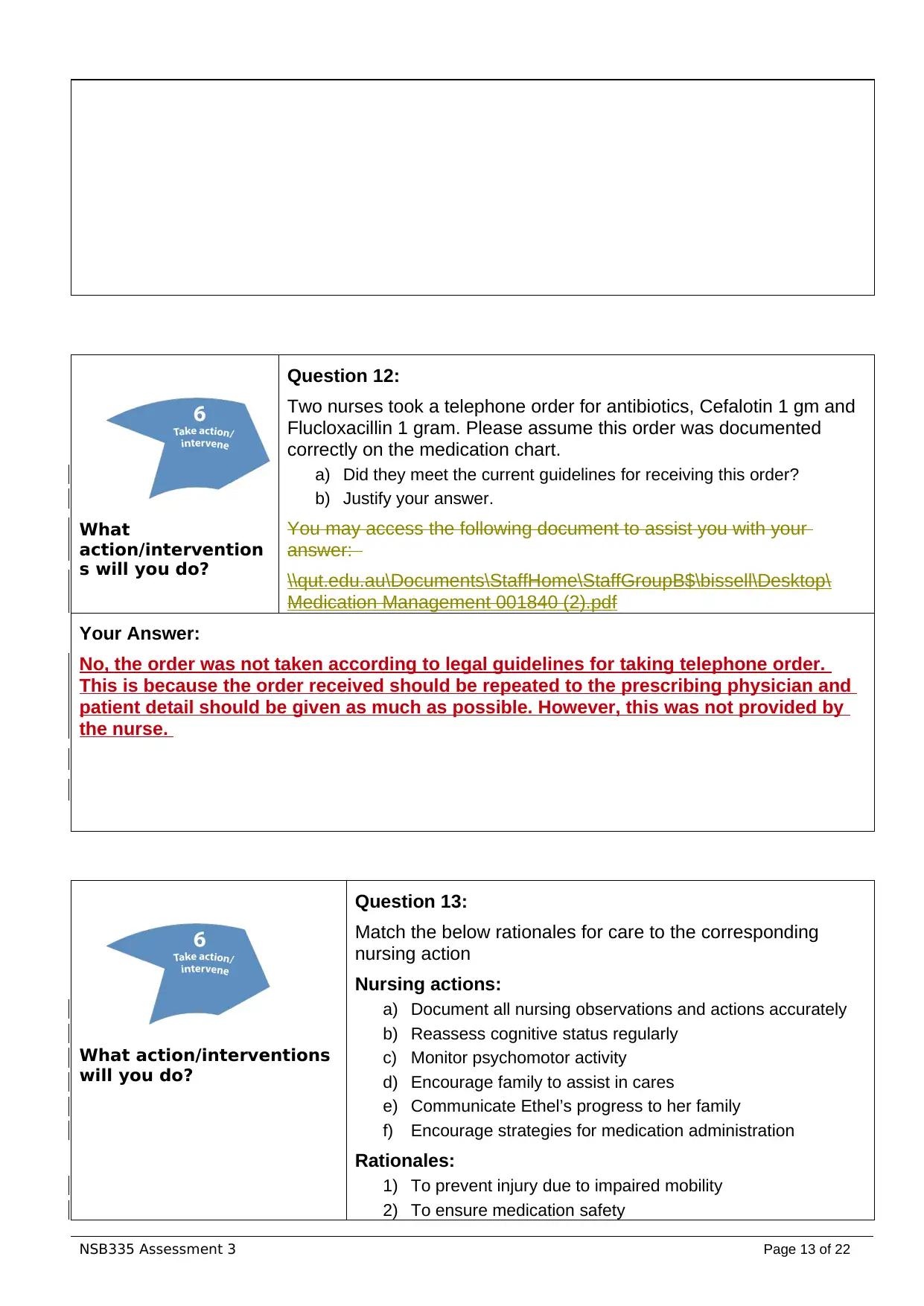
What
action/intervention
s will you do?
Question 12:
Two nurses took a telephone order for antibiotics, Cefalotin 1 gm and
Flucloxacillin 1 gram. Please assume this order was documented
correctly on the medication chart.
a) Did they meet the current guidelines for receiving this order?
b) Justify your answer.
You may access the following document to assist you with your
answer:
\\qut.edu.au\Documents\StaffHome\StaffGroupB$\bissell\Desktop\
Medication Management 001840 (2).pdf
Your Answer:
No, the order was not taken according to legal guidelines for taking telephone order.
This is because the order received should be repeated to the prescribing physician and
patient detail should be given as much as possible. However, this was not provided by
the nurse.
What action/interventions
will you do?
Question 13:
Match the below rationales for care to the corresponding
nursing action
Nursing actions:
a) Document all nursing observations and actions accurately
b) Reassess cognitive status regularly
c) Monitor psychomotor activity
d) Encourage family to assist in cares
e) Communicate Ethel’s progress to her family
f) Encourage strategies for medication administration
Rationales:
1) To prevent injury due to impaired mobility
2) To ensure medication safety
NSB335 Assessment 3 Page 13 of 22
action/intervention
s will you do?
Question 12:
Two nurses took a telephone order for antibiotics, Cefalotin 1 gm and
Flucloxacillin 1 gram. Please assume this order was documented
correctly on the medication chart.
a) Did they meet the current guidelines for receiving this order?
b) Justify your answer.
You may access the following document to assist you with your
answer:
\\qut.edu.au\Documents\StaffHome\StaffGroupB$\bissell\Desktop\
Medication Management 001840 (2).pdf
Your Answer:
No, the order was not taken according to legal guidelines for taking telephone order.
This is because the order received should be repeated to the prescribing physician and
patient detail should be given as much as possible. However, this was not provided by
the nurse.
What action/interventions
will you do?
Question 13:
Match the below rationales for care to the corresponding
nursing action
Nursing actions:
a) Document all nursing observations and actions accurately
b) Reassess cognitive status regularly
c) Monitor psychomotor activity
d) Encourage family to assist in cares
e) Communicate Ethel’s progress to her family
f) Encourage strategies for medication administration
Rationales:
1) To prevent injury due to impaired mobility
2) To ensure medication safety
NSB335 Assessment 3 Page 13 of 22
Paraphrase This Document
Need a fresh take? Get an instant paraphrase of this document with our AI Paraphraser
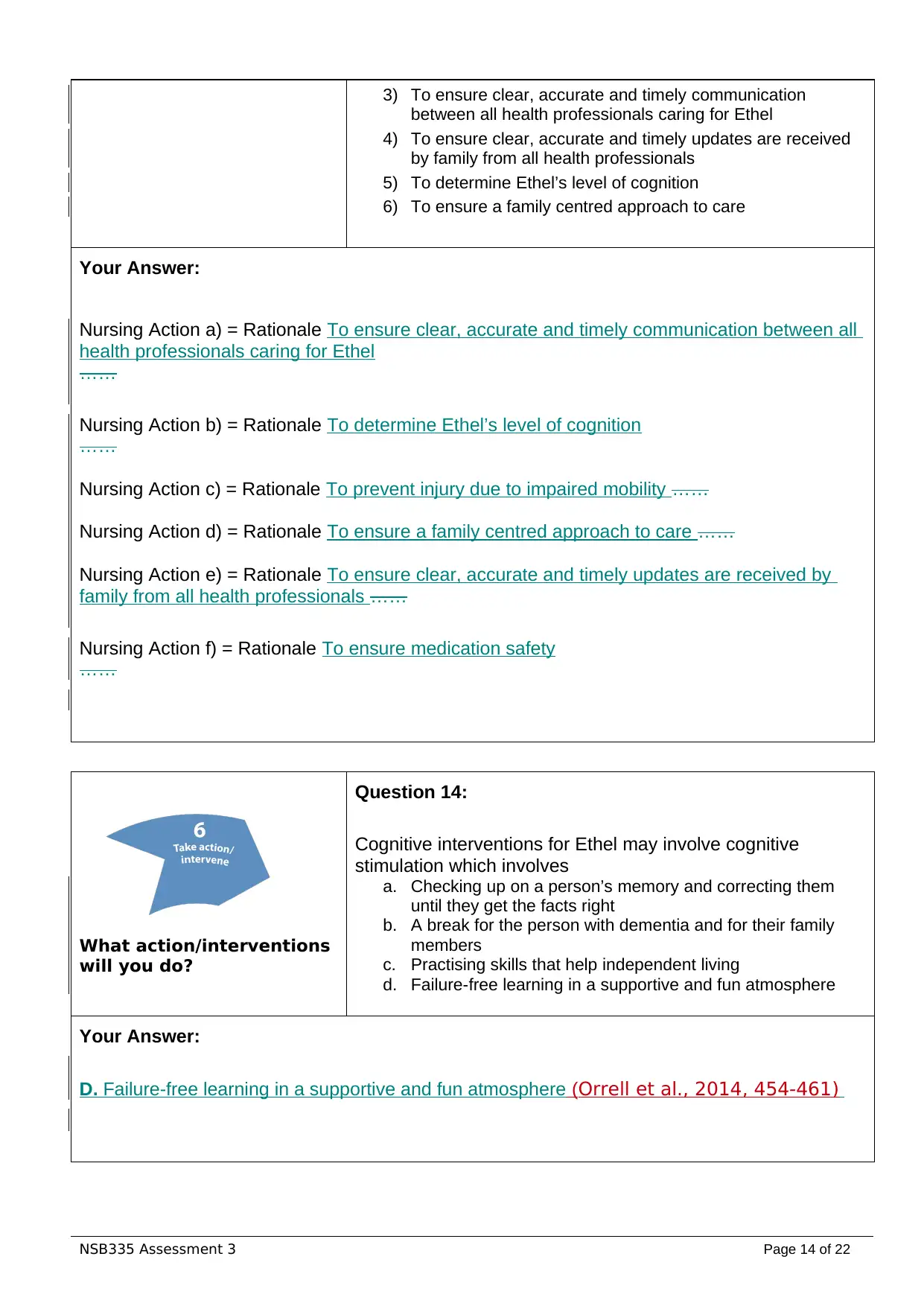
3) To ensure clear, accurate and timely communication
between all health professionals caring for Ethel
4) To ensure clear, accurate and timely updates are received
by family from all health professionals
5) To determine Ethel’s level of cognition
6) To ensure a family centred approach to care
Your Answer:
Nursing Action a) = Rationale To ensure clear, accurate and timely communication between all
health professionals caring for Ethel
……
Nursing Action b) = Rationale To determine Ethel’s level of cognition
……
Nursing Action c) = Rationale To prevent injury due to impaired mobility ……
Nursing Action d) = Rationale To ensure a family centred approach to care ……
Nursing Action e) = Rationale To ensure clear, accurate and timely updates are received by
family from all health professionals ……
Nursing Action f) = Rationale To ensure medication safety
……
What action/interventions
will you do?
Question 14:
Cognitive interventions for Ethel may involve cognitive
stimulation which involves
a. Checking up on a person’s memory and correcting them
until they get the facts right
b. A break for the person with dementia and for their family
members
c. Practising skills that help independent living
d. Failure-free learning in a supportive and fun atmosphere
Your Answer:
D. Failure-free learning in a supportive and fun atmosphere (Orrell et al., 2014, 454-461)
NSB335 Assessment 3 Page 14 of 22
between all health professionals caring for Ethel
4) To ensure clear, accurate and timely updates are received
by family from all health professionals
5) To determine Ethel’s level of cognition
6) To ensure a family centred approach to care
Your Answer:
Nursing Action a) = Rationale To ensure clear, accurate and timely communication between all
health professionals caring for Ethel
……
Nursing Action b) = Rationale To determine Ethel’s level of cognition
……
Nursing Action c) = Rationale To prevent injury due to impaired mobility ……
Nursing Action d) = Rationale To ensure a family centred approach to care ……
Nursing Action e) = Rationale To ensure clear, accurate and timely updates are received by
family from all health professionals ……
Nursing Action f) = Rationale To ensure medication safety
……
What action/interventions
will you do?
Question 14:
Cognitive interventions for Ethel may involve cognitive
stimulation which involves
a. Checking up on a person’s memory and correcting them
until they get the facts right
b. A break for the person with dementia and for their family
members
c. Practising skills that help independent living
d. Failure-free learning in a supportive and fun atmosphere
Your Answer:
D. Failure-free learning in a supportive and fun atmosphere (Orrell et al., 2014, 454-461)
NSB335 Assessment 3 Page 14 of 22

What action/interventions
will you do?
Question 15:
Whilst Ethel’s knee pain from arthritis will be resolved with the
surgery, she also has ongoing mild to moderate pain in both
ankles also due to arthritis. In addition to taking the
prescribed Non-Steroidal Anti-Inflammatory Drug, as a nurse
you should also instruct her to:
a. Start a regular exercise program
b. Avoid foods high in citrus acid
c. Keep legs elevated when sitting
d. Rest her feet and ankles as much as possible to decrease
inflammation
Give a rationale for your answer to Q15?
Your Answer:
I would suggest the patient to start exercising regularly, as it is leading non-
pharmacological intervention technique for the arthritis patients. along with that
the effects of aging can also lead to joint inflammation, pain and mobility restriction
in general, the exercise will help keep her body active and flexible as much as
possible (Loeser et al., 2012, pp. 1697-1707). According to the evidences, aerobic,
range-of-motion and strengthening exercises had been reported to be the most
beneficial for the osteoarthritis patient and I will suggest them to her and will also
refer her to a occupational therapist or fitness expert.
Assess the effectiveness
of actions
Question 16:
List two signs and symptoms that would indicate that Ethel’s
goals are being achieved:
a) Ethel has no falls.
b) Weight reduced.
c) Ethel’s pain reduces.
d) Ethel’s cognitive status improves.
e) Ethel is less aggressive
f) Ethel’s agitation increases
g) Ethel is comfortably situated in a residential aged care
facility.
h) The inflammation around the suture line and the purulent
ooze will resolve within 3 days.
NSB335 Assessment 3 Page 15 of 22
will you do?
Question 15:
Whilst Ethel’s knee pain from arthritis will be resolved with the
surgery, she also has ongoing mild to moderate pain in both
ankles also due to arthritis. In addition to taking the
prescribed Non-Steroidal Anti-Inflammatory Drug, as a nurse
you should also instruct her to:
a. Start a regular exercise program
b. Avoid foods high in citrus acid
c. Keep legs elevated when sitting
d. Rest her feet and ankles as much as possible to decrease
inflammation
Give a rationale for your answer to Q15?
Your Answer:
I would suggest the patient to start exercising regularly, as it is leading non-
pharmacological intervention technique for the arthritis patients. along with that
the effects of aging can also lead to joint inflammation, pain and mobility restriction
in general, the exercise will help keep her body active and flexible as much as
possible (Loeser et al., 2012, pp. 1697-1707). According to the evidences, aerobic,
range-of-motion and strengthening exercises had been reported to be the most
beneficial for the osteoarthritis patient and I will suggest them to her and will also
refer her to a occupational therapist or fitness expert.
Assess the effectiveness
of actions
Question 16:
List two signs and symptoms that would indicate that Ethel’s
goals are being achieved:
a) Ethel has no falls.
b) Weight reduced.
c) Ethel’s pain reduces.
d) Ethel’s cognitive status improves.
e) Ethel is less aggressive
f) Ethel’s agitation increases
g) Ethel is comfortably situated in a residential aged care
facility.
h) The inflammation around the suture line and the purulent
ooze will resolve within 3 days.
NSB335 Assessment 3 Page 15 of 22
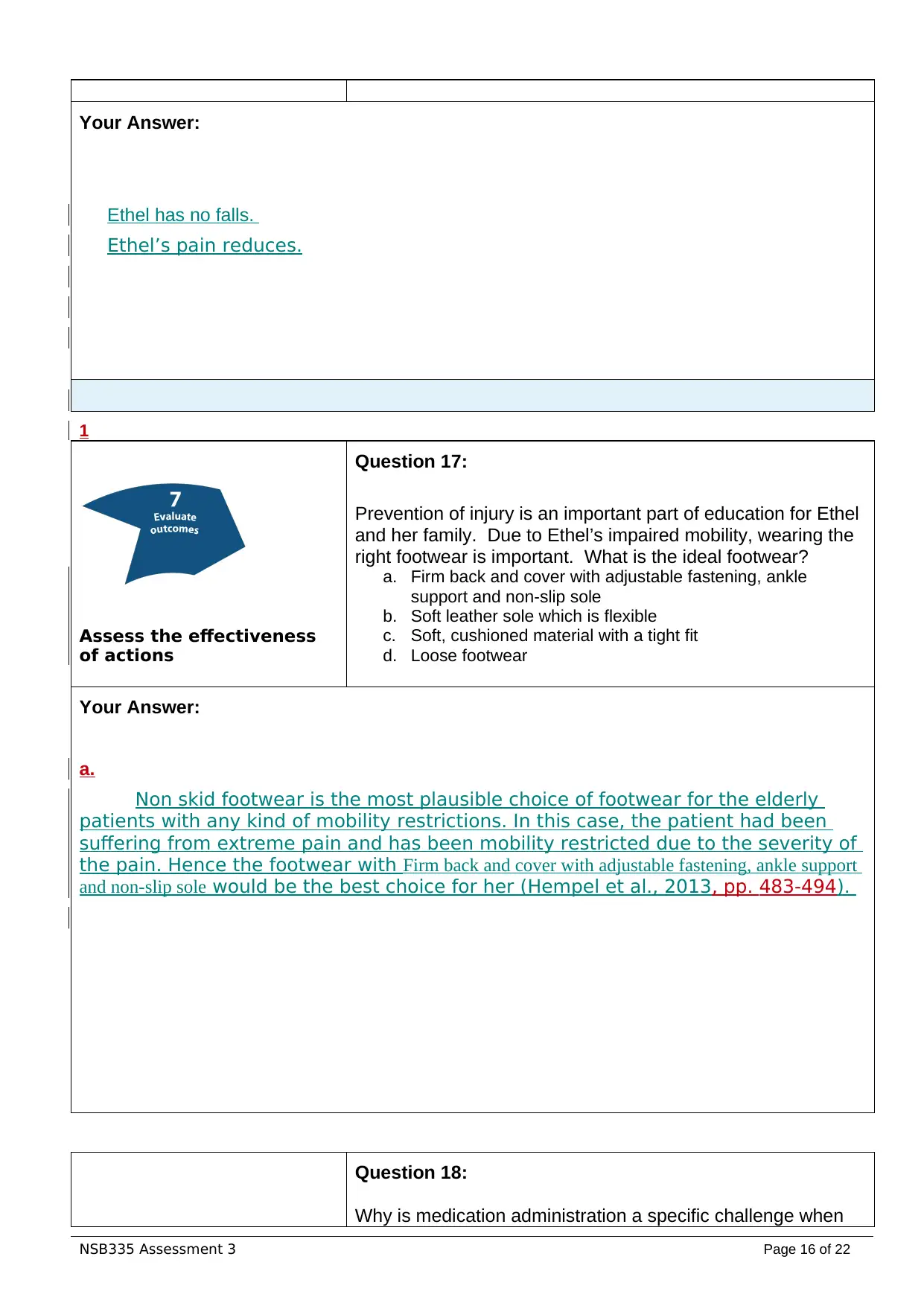
Your Answer:
Ethel has no falls.
Ethel’s pain reduces.
1
Assess the effectiveness
of actions
Question 17:
Prevention of injury is an important part of education for Ethel
and her family. Due to Ethel’s impaired mobility, wearing the
right footwear is important. What is the ideal footwear?
a. Firm back and cover with adjustable fastening, ankle
support and non-slip sole
b. Soft leather sole which is flexible
c. Soft, cushioned material with a tight fit
d. Loose footwear
Your Answer:
a.
Non skid footwear is the most plausible choice of footwear for the elderly
patients with any kind of mobility restrictions. In this case, the patient had been
suffering from extreme pain and has been mobility restricted due to the severity of
the pain. Hence the footwear with Firm back and cover with adjustable fastening, ankle support
and non-slip sole would be the best choice for her (Hempel et al., 2013, pp. 483-494).
Question 18:
Why is medication administration a specific challenge when
NSB335 Assessment 3 Page 16 of 22
Ethel has no falls.
Ethel’s pain reduces.
1
Assess the effectiveness
of actions
Question 17:
Prevention of injury is an important part of education for Ethel
and her family. Due to Ethel’s impaired mobility, wearing the
right footwear is important. What is the ideal footwear?
a. Firm back and cover with adjustable fastening, ankle
support and non-slip sole
b. Soft leather sole which is flexible
c. Soft, cushioned material with a tight fit
d. Loose footwear
Your Answer:
a.
Non skid footwear is the most plausible choice of footwear for the elderly
patients with any kind of mobility restrictions. In this case, the patient had been
suffering from extreme pain and has been mobility restricted due to the severity of
the pain. Hence the footwear with Firm back and cover with adjustable fastening, ankle support
and non-slip sole would be the best choice for her (Hempel et al., 2013, pp. 483-494).
Question 18:
Why is medication administration a specific challenge when
NSB335 Assessment 3 Page 16 of 22
Secure Best Marks with AI Grader
Need help grading? Try our AI Grader for instant feedback on your assignments.
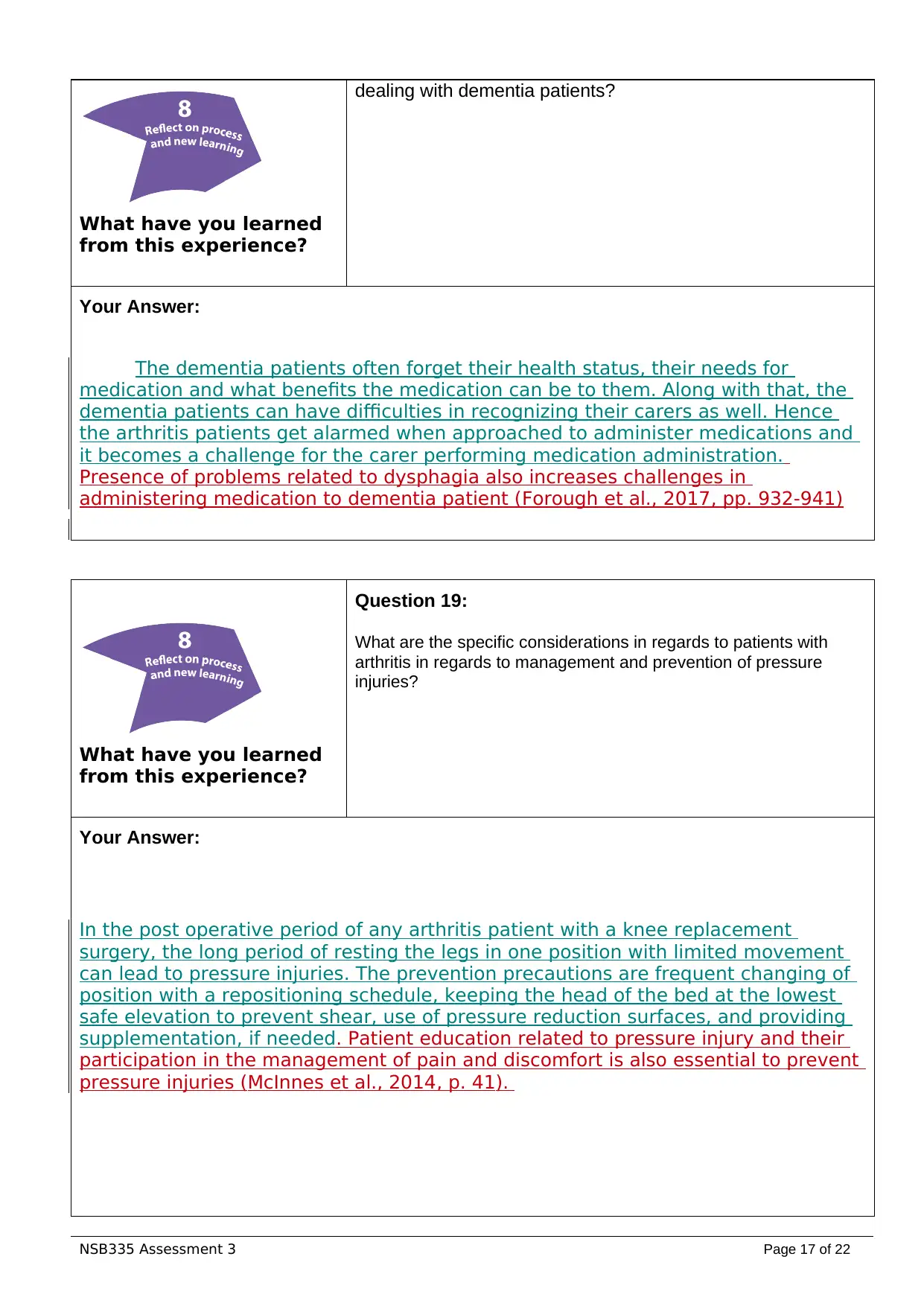
What have you learned
from this experience?
dealing with dementia patients?
Your Answer:
The dementia patients often forget their health status, their needs for
medication and what benefits the medication can be to them. Along with that, the
dementia patients can have difficulties in recognizing their carers as well. Hence
the arthritis patients get alarmed when approached to administer medications and
it becomes a challenge for the carer performing medication administration.
Presence of problems related to dysphagia also increases challenges in
administering medication to dementia patient (Forough et al., 2017, pp. 932-941)
What have you learned
from this experience?
Question 19:
What are the specific considerations in regards to patients with
arthritis in regards to management and prevention of pressure
injuries?
Your Answer:
In the post operative period of any arthritis patient with a knee replacement
surgery, the long period of resting the legs in one position with limited movement
can lead to pressure injuries. The prevention precautions are frequent changing of
position with a repositioning schedule, keeping the head of the bed at the lowest
safe elevation to prevent shear, use of pressure reduction surfaces, and providing
supplementation, if needed. Patient education related to pressure injury and their
participation in the management of pain and discomfort is also essential to prevent
pressure injuries (McInnes et al., 2014, p. 41).
NSB335 Assessment 3 Page 17 of 22
from this experience?
dealing with dementia patients?
Your Answer:
The dementia patients often forget their health status, their needs for
medication and what benefits the medication can be to them. Along with that, the
dementia patients can have difficulties in recognizing their carers as well. Hence
the arthritis patients get alarmed when approached to administer medications and
it becomes a challenge for the carer performing medication administration.
Presence of problems related to dysphagia also increases challenges in
administering medication to dementia patient (Forough et al., 2017, pp. 932-941)
What have you learned
from this experience?
Question 19:
What are the specific considerations in regards to patients with
arthritis in regards to management and prevention of pressure
injuries?
Your Answer:
In the post operative period of any arthritis patient with a knee replacement
surgery, the long period of resting the legs in one position with limited movement
can lead to pressure injuries. The prevention precautions are frequent changing of
position with a repositioning schedule, keeping the head of the bed at the lowest
safe elevation to prevent shear, use of pressure reduction surfaces, and providing
supplementation, if needed. Patient education related to pressure injury and their
participation in the management of pain and discomfort is also essential to prevent
pressure injuries (McInnes et al., 2014, p. 41).
NSB335 Assessment 3 Page 17 of 22

What have you learned from
this experience?
Question 20:
Ethel is taking Ibuprofen for pain.
a) Discuss the mode of action of this medication
b) Discuss the side effects and contraindications of ibuprofen
that Ethel is taking
c) Do you think this is the best medication for Ethel? Why?
Your Answer:
Mechanism of action is blocking the production of prostaglandins that are
secreted in the body in response to any illness or injury and facilitate the sensation
of pain. By blocking the production of the prostaglandins the pain sensation is
eliminated in the patient taking ibuprofen
The side effects of the medicine includes dysentery, nausea, vomiting,
headache, diarrhea, constipation, dizziness and even drowsiness. The
contraindications are hypersensitivity reaction, gastrointestinal bleeding or
presence or peptic ulcer. The risk of renal insufficiency and prolonged
bleeding time is also high for Ethel given her age and present medical
condition (Nissen et al., 2016, 2519-2529).
No, NSAID medications are not first recommendation for elderly patients for
the side effects and their age derived vulnerabilities (Park, Qin & Bavry, 2012,
pp. 167-177).. Hence, it is not best choice for Ethel.
NSB335 Assessment 3 Page 18 of 22
this experience?
Question 20:
Ethel is taking Ibuprofen for pain.
a) Discuss the mode of action of this medication
b) Discuss the side effects and contraindications of ibuprofen
that Ethel is taking
c) Do you think this is the best medication for Ethel? Why?
Your Answer:
Mechanism of action is blocking the production of prostaglandins that are
secreted in the body in response to any illness or injury and facilitate the sensation
of pain. By blocking the production of the prostaglandins the pain sensation is
eliminated in the patient taking ibuprofen
The side effects of the medicine includes dysentery, nausea, vomiting,
headache, diarrhea, constipation, dizziness and even drowsiness. The
contraindications are hypersensitivity reaction, gastrointestinal bleeding or
presence or peptic ulcer. The risk of renal insufficiency and prolonged
bleeding time is also high for Ethel given her age and present medical
condition (Nissen et al., 2016, 2519-2529).
No, NSAID medications are not first recommendation for elderly patients for
the side effects and their age derived vulnerabilities (Park, Qin & Bavry, 2012,
pp. 167-177).. Hence, it is not best choice for Ethel.
NSB335 Assessment 3 Page 18 of 22

NSB335 Assessment 3 Page 19 of 22
Paraphrase This Document
Need a fresh take? Get an instant paraphrase of this document with our AI Paraphraser
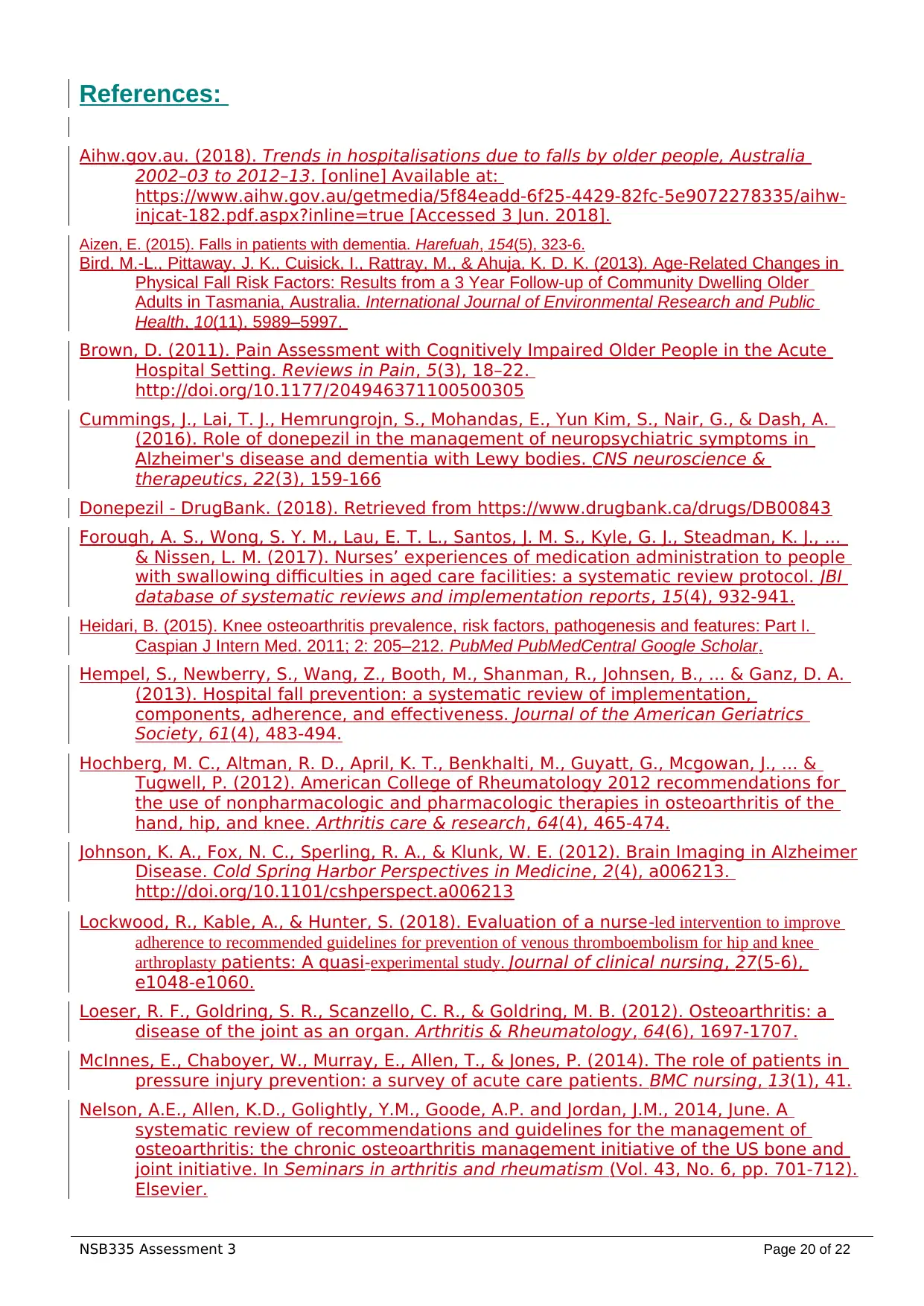
References:
Aihw.gov.au. (2018). Trends in hospitalisations due to falls by older people, Australia
2002–03 to 2012–13. [online] Available at:
https://www.aihw.gov.au/getmedia/5f84eadd-6f25-4429-82fc-5e9072278335/aihw-
injcat-182.pdf.aspx?inline=true [Accessed 3 Jun. 2018].
Aizen, E. (2015). Falls in patients with dementia. Harefuah, 154(5), 323-6.
Bird, M.-L., Pittaway, J. K., Cuisick, I., Rattray, M., & Ahuja, K. D. K. (2013). Age-Related Changes in
Physical Fall Risk Factors: Results from a 3 Year Follow-up of Community Dwelling Older
Adults in Tasmania, Australia. International Journal of Environmental Research and Public
Health, 10(11), 5989–5997.
Brown, D. (2011). Pain Assessment with Cognitively Impaired Older People in the Acute
Hospital Setting. Reviews in Pain, 5(3), 18–22.
http://doi.org/10.1177/204946371100500305
Cummings, J., Lai, T. J., Hemrungrojn, S., Mohandas, E., Yun Kim, S., Nair, G., & Dash, A.
(2016). Role of donepezil in the management of neuropsychiatric symptoms in
Alzheimer's disease and dementia with Lewy bodies. CNS neuroscience &
therapeutics, 22(3), 159-166
Donepezil - DrugBank. (2018). Retrieved from https://www.drugbank.ca/drugs/DB00843
Forough, A. S., Wong, S. Y. M., Lau, E. T. L., Santos, J. M. S., Kyle, G. J., Steadman, K. J., ...
& Nissen, L. M. (2017). Nurses’ experiences of medication administration to people
with swallowing difficulties in aged care facilities: a systematic review protocol. JBI
database of systematic reviews and implementation reports, 15(4), 932-941.
Heidari, B. (2015). Knee osteoarthritis prevalence, risk factors, pathogenesis and features: Part I.
Caspian J Intern Med. 2011; 2: 205–212. PubMed PubMedCentral Google Scholar.
Hempel, S., Newberry, S., Wang, Z., Booth, M., Shanman, R., Johnsen, B., ... & Ganz, D. A.
(2013). Hospital fall prevention: a systematic review of implementation,
components, adherence, and effectiveness. Journal of the American Geriatrics
Society, 61(4), 483-494.
Hochberg, M. C., Altman, R. D., April, K. T., Benkhalti, M., Guyatt, G., Mcgowan, J., ... &
Tugwell, P. (2012). American College of Rheumatology 2012 recommendations for
the use of nonpharmacologic and pharmacologic therapies in osteoarthritis of the
hand, hip, and knee. Arthritis care & research, 64(4), 465-474.
Johnson, K. A., Fox, N. C., Sperling, R. A., & Klunk, W. E. (2012). Brain Imaging in Alzheimer
Disease. Cold Spring Harbor Perspectives in Medicine, 2(4), a006213.
http://doi.org/10.1101/cshperspect.a006213
Lockwood, R., Kable, A., & Hunter, S. (2018). Evaluation of a nurse‐led intervention to improve
adherence to recommended guidelines for prevention of venous thromboembolism for hip and knee
arthroplasty patients: A quasi‐experimental study. Journal of clinical nursing, 27(5-6),
e1048-e1060.
Loeser, R. F., Goldring, S. R., Scanzello, C. R., & Goldring, M. B. (2012). Osteoarthritis: a
disease of the joint as an organ. Arthritis & Rheumatology, 64(6), 1697-1707.
McInnes, E., Chaboyer, W., Murray, E., Allen, T., & Jones, P. (2014). The role of patients in
pressure injury prevention: a survey of acute care patients. BMC nursing, 13(1), 41.
Nelson, A.E., Allen, K.D., Golightly, Y.M., Goode, A.P. and Jordan, J.M., 2014, June. A
systematic review of recommendations and guidelines for the management of
osteoarthritis: the chronic osteoarthritis management initiative of the US bone and
joint initiative. In Seminars in arthritis and rheumatism (Vol. 43, No. 6, pp. 701-712).
Elsevier.
NSB335 Assessment 3 Page 20 of 22
Aihw.gov.au. (2018). Trends in hospitalisations due to falls by older people, Australia
2002–03 to 2012–13. [online] Available at:
https://www.aihw.gov.au/getmedia/5f84eadd-6f25-4429-82fc-5e9072278335/aihw-
injcat-182.pdf.aspx?inline=true [Accessed 3 Jun. 2018].
Aizen, E. (2015). Falls in patients with dementia. Harefuah, 154(5), 323-6.
Bird, M.-L., Pittaway, J. K., Cuisick, I., Rattray, M., & Ahuja, K. D. K. (2013). Age-Related Changes in
Physical Fall Risk Factors: Results from a 3 Year Follow-up of Community Dwelling Older
Adults in Tasmania, Australia. International Journal of Environmental Research and Public
Health, 10(11), 5989–5997.
Brown, D. (2011). Pain Assessment with Cognitively Impaired Older People in the Acute
Hospital Setting. Reviews in Pain, 5(3), 18–22.
http://doi.org/10.1177/204946371100500305
Cummings, J., Lai, T. J., Hemrungrojn, S., Mohandas, E., Yun Kim, S., Nair, G., & Dash, A.
(2016). Role of donepezil in the management of neuropsychiatric symptoms in
Alzheimer's disease and dementia with Lewy bodies. CNS neuroscience &
therapeutics, 22(3), 159-166
Donepezil - DrugBank. (2018). Retrieved from https://www.drugbank.ca/drugs/DB00843
Forough, A. S., Wong, S. Y. M., Lau, E. T. L., Santos, J. M. S., Kyle, G. J., Steadman, K. J., ...
& Nissen, L. M. (2017). Nurses’ experiences of medication administration to people
with swallowing difficulties in aged care facilities: a systematic review protocol. JBI
database of systematic reviews and implementation reports, 15(4), 932-941.
Heidari, B. (2015). Knee osteoarthritis prevalence, risk factors, pathogenesis and features: Part I.
Caspian J Intern Med. 2011; 2: 205–212. PubMed PubMedCentral Google Scholar.
Hempel, S., Newberry, S., Wang, Z., Booth, M., Shanman, R., Johnsen, B., ... & Ganz, D. A.
(2013). Hospital fall prevention: a systematic review of implementation,
components, adherence, and effectiveness. Journal of the American Geriatrics
Society, 61(4), 483-494.
Hochberg, M. C., Altman, R. D., April, K. T., Benkhalti, M., Guyatt, G., Mcgowan, J., ... &
Tugwell, P. (2012). American College of Rheumatology 2012 recommendations for
the use of nonpharmacologic and pharmacologic therapies in osteoarthritis of the
hand, hip, and knee. Arthritis care & research, 64(4), 465-474.
Johnson, K. A., Fox, N. C., Sperling, R. A., & Klunk, W. E. (2012). Brain Imaging in Alzheimer
Disease. Cold Spring Harbor Perspectives in Medicine, 2(4), a006213.
http://doi.org/10.1101/cshperspect.a006213
Lockwood, R., Kable, A., & Hunter, S. (2018). Evaluation of a nurse‐led intervention to improve
adherence to recommended guidelines for prevention of venous thromboembolism for hip and knee
arthroplasty patients: A quasi‐experimental study. Journal of clinical nursing, 27(5-6),
e1048-e1060.
Loeser, R. F., Goldring, S. R., Scanzello, C. R., & Goldring, M. B. (2012). Osteoarthritis: a
disease of the joint as an organ. Arthritis & Rheumatology, 64(6), 1697-1707.
McInnes, E., Chaboyer, W., Murray, E., Allen, T., & Jones, P. (2014). The role of patients in
pressure injury prevention: a survey of acute care patients. BMC nursing, 13(1), 41.
Nelson, A.E., Allen, K.D., Golightly, Y.M., Goode, A.P. and Jordan, J.M., 2014, June. A
systematic review of recommendations and guidelines for the management of
osteoarthritis: the chronic osteoarthritis management initiative of the US bone and
joint initiative. In Seminars in arthritis and rheumatism (Vol. 43, No. 6, pp. 701-712).
Elsevier.
NSB335 Assessment 3 Page 20 of 22

Nissen, S. E., Yeomans, N. D., Solomon, D. H., Lüscher, T. F., Libby, P., Husni, M. E., ... &
Wang, Q. (2016). Cardiovascular safety of celecoxib, naproxen, or ibuprofen for
arthritis. New England Journal of Medicine, 375, 2519-2529.
Park, K. E., Qin, Y., & Bavry, A. A. (2012). Nonsteroidal anti-inflammatory drugs and their
effects in the elderly. Aging Health, 8(2), 167-177.
Thomas, C., Kreisel, S. H., Oster, P., Driessen, M., Arolt, V., & Inouye, S. K. (2012).
Diagnosing delirium in older hospitalized adults with dementia: adapting the
confusion assessment method to international classification of diseases, tenth
revision, diagnostic criteria. Journal of the American Geriatrics Society, 60(8), 1471-
1477.
Travis, S. S., Kao, H. F. S., & Acton, G. J. (2016). Helping family members manage
medication administration hassles. Journal of psychosocial nursing and mental
health services, 43(11), 13-15
NSB335 Assessment 3 Page 21 of 22
Wang, Q. (2016). Cardiovascular safety of celecoxib, naproxen, or ibuprofen for
arthritis. New England Journal of Medicine, 375, 2519-2529.
Park, K. E., Qin, Y., & Bavry, A. A. (2012). Nonsteroidal anti-inflammatory drugs and their
effects in the elderly. Aging Health, 8(2), 167-177.
Thomas, C., Kreisel, S. H., Oster, P., Driessen, M., Arolt, V., & Inouye, S. K. (2012).
Diagnosing delirium in older hospitalized adults with dementia: adapting the
confusion assessment method to international classification of diseases, tenth
revision, diagnostic criteria. Journal of the American Geriatrics Society, 60(8), 1471-
1477.
Travis, S. S., Kao, H. F. S., & Acton, G. J. (2016). Helping family members manage
medication administration hassles. Journal of psychosocial nursing and mental
health services, 43(11), 13-15
NSB335 Assessment 3 Page 21 of 22
1 out of 21
Your All-in-One AI-Powered Toolkit for Academic Success.
+13062052269
info@desklib.com
Available 24*7 on WhatsApp / Email
![[object Object]](/_next/static/media/star-bottom.7253800d.svg)
Unlock your academic potential
© 2024 | Zucol Services PVT LTD | All rights reserved.

